#English translation Chinese writer
Explore tagged Tumblr posts
Text


continuing mlp theme.. i'm very impressed by lbh abilities to affect other people dreams and find it a really useful skill - he can share any media without using the internet, that's so freaking awesome!
i think his world will enjoy this little gift
#svsss#luo binghe#shen qingqiu#bingqiu#will the world change being affected by mlp?#hope you like my google translate imitation#idk if connecting to other people dream realms looks like skype or zoom meeting but it would be really funny if so#if i misused flower meaning feel free to correct me#love weird long naming system where instead of three words in English (and four hieroglyphs in Chinese) is used a lot more#idk who had written this book cause all writers from original book don't seem right to me
68 notes
·
View notes
Text
just curious, do yall still want/are interested in another translated version of the mdzs original text? I’m fully fluent in English, love books, write fiction myself (graduated with a minor in creative writing as well), and 80% fluent in written and spoken Chinese. If I may, I can offer a more writerly/authorly + detailed (definitely not in the way of more embellished) interpretation and formatting translation of the og text which I feel that the Seven Seas ver is lacking. But I will probably need one or two others’ help in proofreading and cross checking translations!
#also#just checked back to the seven seas ver and realised there are sentences that don’t seem to be part of the og copy i have#actually lmao I can’t imagine translating the smut scenes from Chinese#save me#mdzs#mxtx#mo dao zu shi#I’ve read the translated ver before seven seas#years ago#and iirc the formatting and sentence structures were stilting#was it the exr#I think so#ngl it is time consuming for me to read Chinese texts#I can’t read quite as fast#bc my first language is english#Chinese is my mother tongue#but I love mdzs so#IM WILLING#I’m just lacking in the idioms department… so I will need help cross checking interpretations#but overall I can grasp the text#grandmaster of demonic cultivation#idk but the seven seas versions for all of mxtx’s novels don’t hit quite right for me#the texts lack depth in the way of sentence structure and phrasing#for a lack of words they feel kind of superficial at times#idk it’s a writer + translation thing for me
5 notes
·
View notes
Text
The thing that bothers me about the majority of multiverse interpretations is that they're not actual multiverses
A world is what people live in (think like, planets), and the same person can exist in multiple versions across different worlds in one universe
A universe is not a world. A universe is not something civilization or anything lives on. It's a (seemingly) infinite box containing all the worlds but is not a world of its own (like the galaxy)
Or in MiHoyos interpretation: the universe is described as a tree with infinite branches and leafs, with each one containing a world
Multiple universes and multiple worlds are not two interchangeable concepts, they are completely different things
Stop immediately reaching for multiple universes when multiple worlds is what you're looking for and is also much more comprehensive and easier to explain
#🐀#like em or not MiHoyo actually gets this concept right#other writers need to learn from them#I mean the original chinese text not the bad english translations because they also get it wrong
1 note
·
View note
Text
The Many Languages of Dick Grayson
Apparently, according to Nightwing #54, he can speak 12, so I went on a little quest to see just how many I could identify.
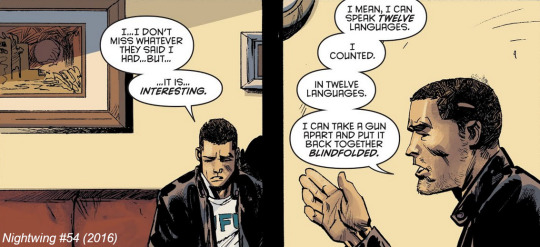
Starting off with The Essential Batman Encyclopedia, the entry for Dick Grayson lists him as being trained in French, Spanish, Russian, Japanese, Mandarin, and Cantonese with having some proficiency in an unknown Romani dialect. Given there are multiple examples of him speaking these languages throughout the comics, I am inclined to trust this claim. To start, we've got several examples of French (Gotham Knights #14, Detective Comics Annual #12, Nightwing #73, Grayson #10-- also featuring Spanish)
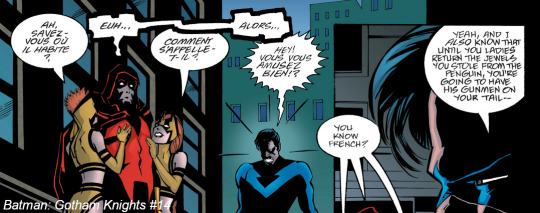
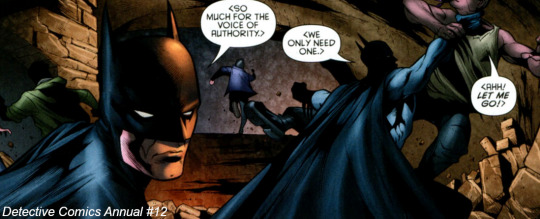
In Grayson #1 he speaks Russian only briefly, but in Detective Comics #36 he speaks it throughout.
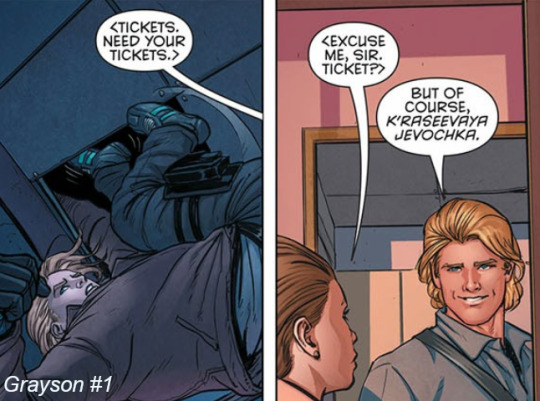
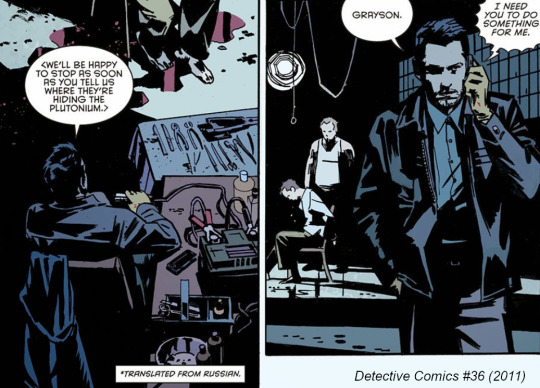
As far as the Chinese languages go, while I believe Dick can speak Mandarin and/or Cantonese fairly well (Batman/Superman World's Finest #3), his Hanzi recognition and literacy could use some work.
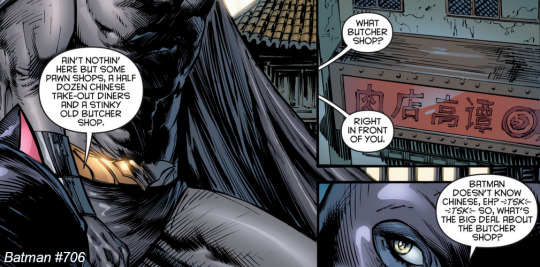
Similarly, when the Titans head off to Japan in Titans Annual #1, we have Nightwing speaking Japanese in battle; however, when it comes to the prospective job of being a manga translator in Nightwing #125, he claims he doesn't know Japanese, which leads me to believe he is only proficient in speaking Japanese/Chinese and struggles with the writing systems.

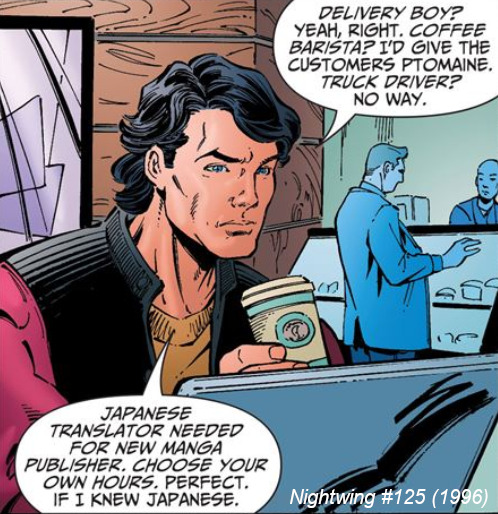
So what about the languages not covered in the encyclopedia? To start, we have another romance language: Italian (Nightwing #72).
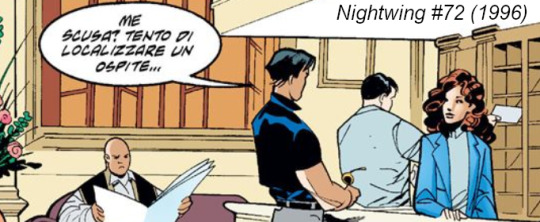
Followed by some alleged German (Nightwing #51, JLA #44)
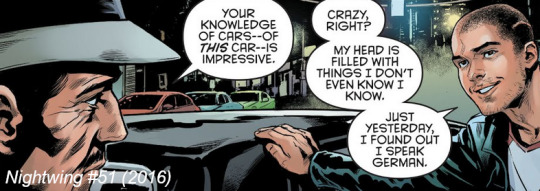
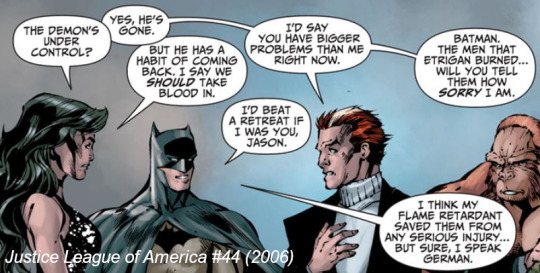
And conversations in Farsi (Robin #175)

While I've seen some Tumblr and Reddit posts claim he knows Kikuyu, The Power Company: Manhunter #1 only says he "brushed up" on his Kikuyu before going to Kenya, so it is unknown how much of the language he actually speaks, but to me it doesn't seem likely to be a lot.

He also, to some unknown degree, speaks Tamaranean-- at least enough to hack into an alien computer (Action Comics #842).
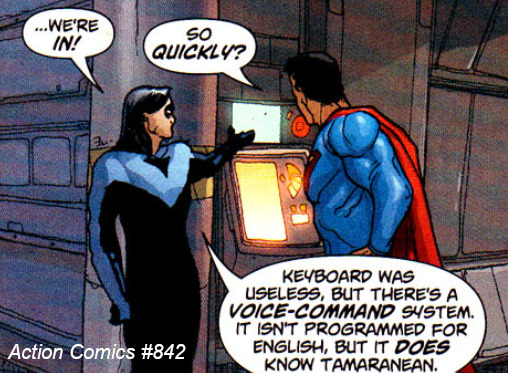
As far as unspoken languages go, Dick is fluent in ASL, which is proven numerous times when he communicates with Jericho (New Teen Titans 1984).

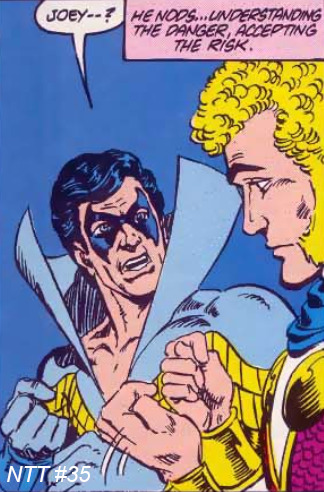
And lastly, the two languages that remain rather uncertain are Romani and Cant-- largely due to the nature of the languages themselves and their representation in comics. "Romani," for instance, has several different dialects, and when Devin Grayson introduced it for Dick (Gotham Knights #20-21, Nightwing #91), she never specified which, and based on the lines she wrote, her research into the language was questionable at best. Writers since have recognized Dick's Romani heritage, but have not otherwise suggested he retained much of the language to be considered fluent.
Cant is an even wider term than Romani and can be seen as more of jargon for a particular language than a language itself, sometimes even being called a "pseudo-language." The colloquial term for American circus cant is Carny, or "Carny speak" as Boston Brand puts it in Batman: The Brave and the Bold #14 when he and Nightwing encounter a kid who speaks it.
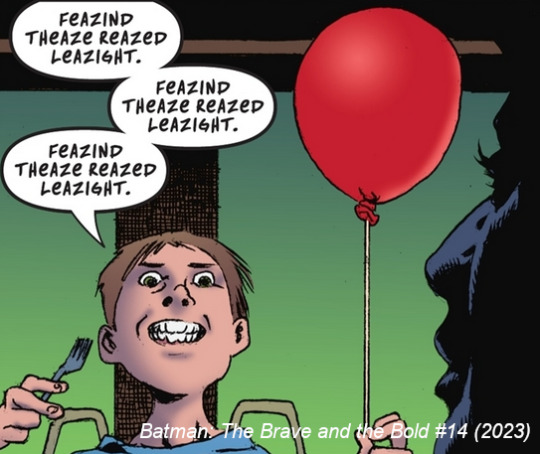
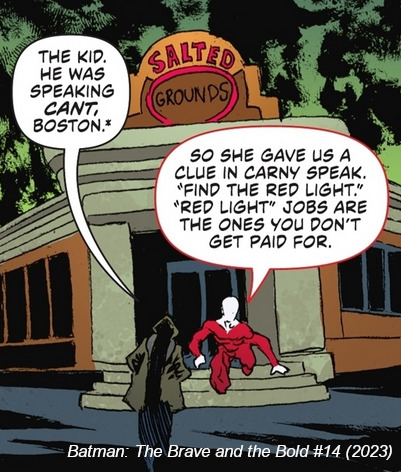
So... this leaves us with 11 languages Dick has notable proficiency in: English, French, Spanish, Italian, Russian, German, Japanese, Mandarin, Cantonese, Farsi, and ASL. And ~3 languages he has unknown proficiency in: Tamaranean, Kikuyu, Romani, and Carny/Cant (if you want to count it).
Maybe memory-loss Dick was including either Tamaranean or Kikuyu in that count from Nightwing #54, or maybe he knows some other language we haven't seen yet. Given how close the family is to the Al Ghuls, I personally think it would be cool if one of them was Arabic.
But anyway, hope you enjoyed this post! A lot I've seen covering this topic are very surface-level and label some of his more iffy languages as "fluent," so I hope this cleared things up. I've read tons of Nightwing, and I swear there are more examples, but sifting through the 1,000+ comics I've read of him is a lot haha. If y'all know of some others, let me know!
#nightwing#dick grayson#romani dick grayson#boy wonder#first robin#language#polyglot character#multilingual character#dc comics#i tried to keep the romani and carny part brief#you could write a whole essay on the languages#i could also write a whole essay on devin grayson's romani rep#or lack thereof#and its problematic nature#but that's a post for another day
586 notes
·
View notes
Text
coldflash fics 2024 wrap up!
I spend too much time hanging around in the coldflash tag on ao3 so here's some data I gathered on the fics published this year!
a total of 171 works published/updated by 87 writers (+orphaned and anonymous authors). it brings the total fics in the tag up to 4991 fics, we're almost at 5000! this is a total of approximately 2,924,914 words, which is over 1.5 times the entire ASOIAF series lol (technically this is an overestimate because I didn't bother excluding word counts of longfic chapters published before 2024 whoops)
34 people published a coldflash fic for the first time this year! welcome, we are very happy to have you :)
14 people published fics in a language other than English (5 Russian, 2 French, 2 Spanish, 2 Chinese, 1 Hungarian, 1 Portuguese, 1 Czech)
16-ish cross over fics (obviously this ship has way more crossovers than usual because len goes over to the legends so I didn't count those, but I DID count those highschool/college/groupchat/watch the show au's where every arrowverse/dcu character is chucked into one fic as a crossover) (my post my rules lmao)
1 podfic, 1 fic set in someone else's fic, and 2 translated fics! the transformative works are getting transformed :D
8 gifted works. much generosity, very wow
most fics: 🥇Lady_Meg_666 with 20 fics 🥈SoftBoyDepot with 10 fics🥉BeauregardsTaxicab with 7 fics
highest word count: 🥇 BeauregardsTaxicab with a total of 519,382 words 🥈alex_jude with a total of 155,458 words🥉MK_Morreaux with a total of 95,957 words
longest fic (began prior to 2024): 🥇Arrowverse watching arrowverse with 381,534 words 🥈That Rare Arctic Thunderstorm with 233,199 words🥉Just for a Second with 118,757 words
longest fic (began 2024):🥇Mr. Blue Sky with 268,722 words 🥈There Are Some Strings on Me with 124,404 words 🥉 This Is What You Came For with 107,485 words
oldest fic writers: 🥇 moriavis first published 25 December 2015 and published 07 February this year 🥈coldflasher first published 28 September 2016 and published 17 December this year 🥉n_a_feathers first published 02 October 2016 and updated 12 May this year
funniest tags goes to "Canon is an Ecclesiastical term and I am a heretic," "Slow Burn but just the feelings part they're having sex the whole time," and "Barry Keeps Learning Things About Himself"
least funny tag goes to "no beta we die like Leonard snart" WHY WERE THERE TWO FICS WITH THIS STOP I'LL CRY
most use of taylor swift lyrics as titles goes to alex_jude with three fics. literally no one else is competing in this category lol
thank you to all the fic writers who kept me well fed this year love you <3
#it's 11pm nobody post any new fics so my data remains accurate!!!#obviously I don't mean to make anyone feel bad with the rankings emphasising long fics but I wasn't sure what other data to track#if you have anything else you would like to see data on I can include that :)#k.txt#coldflash
52 notes
·
View notes
Text
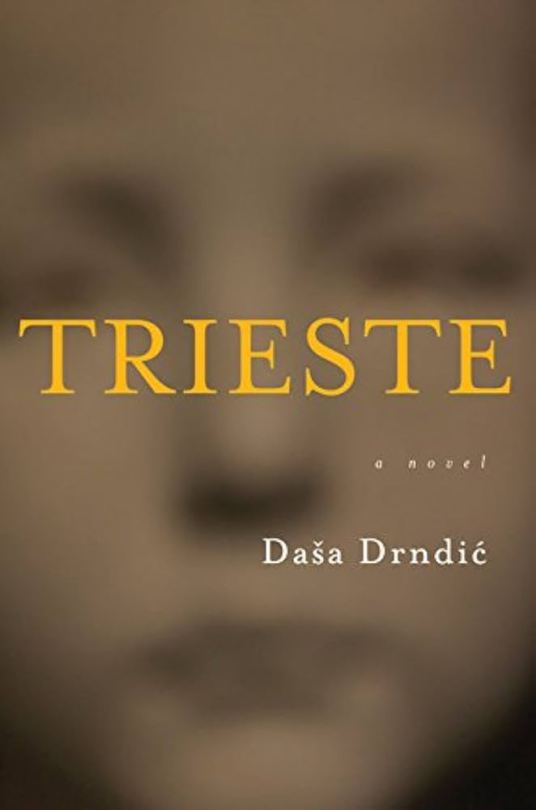
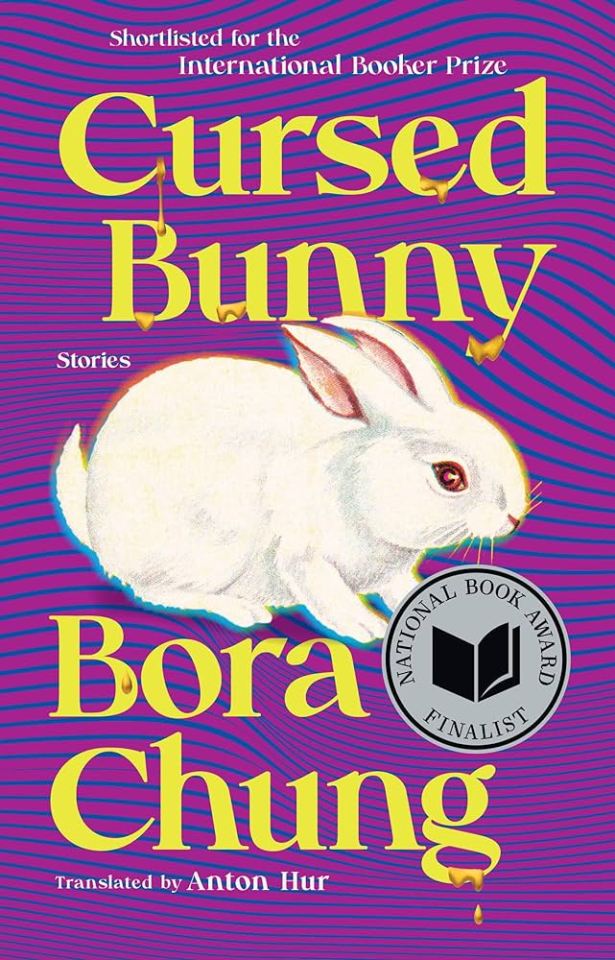



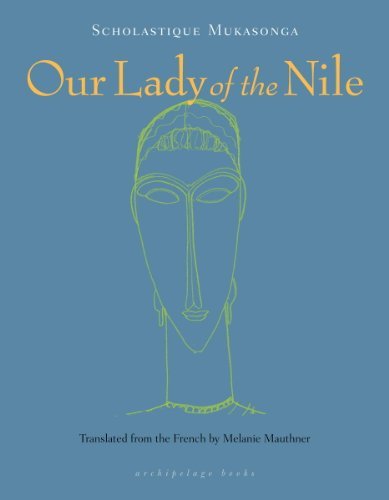
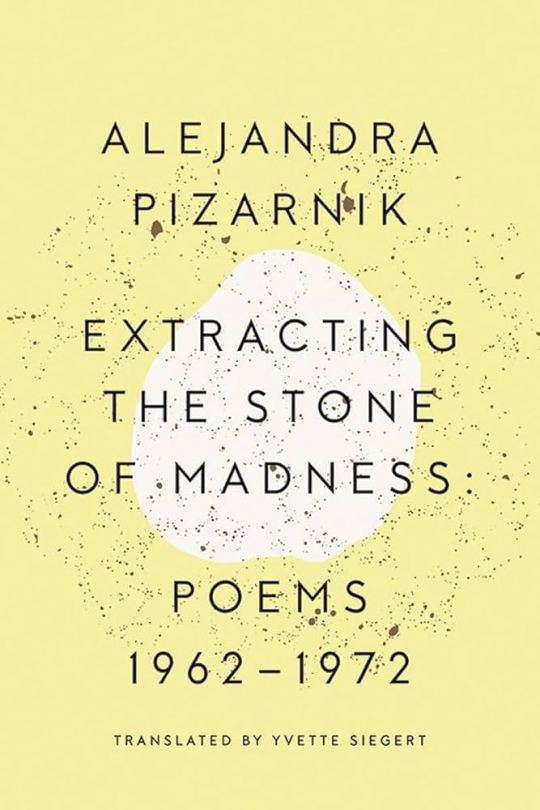


Hi friends! Inspired by @librarycards I wanted to make a post celebrating Women in Translation Month! Anglophone readers generally pay embarrassingly little attention to works in other languages, and that's even more true when it comes to literature by women, so I will jump at any chance to promote my faves 🥰 Here are some recs from 9 different languages! Also, I wrote this on my phone, so apologies for any typos or errors!
1. Trieste by Daša Drndić, trans. Ellen Elias-Bursać (Croatian): An all-time favorite. Much of Drndić's work interrogates the legacy of atrocities in Europe, particularly eastern Europe. Trieste is a haunting contemplative novel centered on an elderly Italian Jewish woman whose family converted to Catholicism during the Mussolini era and were complicit in the fascist violence surrounding them in order to protect themselves.
2. Cursed Bunny by Bora Chung, trans. Anton Hur (Korean): A collection of short stories that are difficult to classify by genre–speculative fiction in the broadest sense. The first story is about a monster in a woman's toilet, which sounds impossible to pull off in a serious, thought-provoking manner, but Chung does so easily—these are the kind of stories that are hard to explain the brilliance of secondhand.
3. Sweet Days of Discipline by Fleur Jaeggy, trans. Tim Parks (Italian; Jaeggy is Swiss): Another all time favorite! The cold, sterile homoerotic girls' boarding school novella of your dreams.
4. Toddler-Hunting and Other Stories by Taeko Kono, trans. Lucy North (Japanese): I think I read this in one sitting. Incredibly unsettling—these stories will stay with you. They often focus on the unspoken psychosexual fantasies underscoring mundane daily life.
5. The Complete Stories by Clarice Lispector, trans. Katrina Dodson (Brazilian Portuguese): I think Lispector is the best known writer here, so she might not need much of an introduction. But what a legend! And this collection is so diverse—it's fascinating to see the evolution of Lispector's work.
6. Our Lady of the Nile by Scholastique Mukasonga, trans. Melanie L. Mauthner (French; Mukasonga is Rwandan): Give her the Nobel! Mukasonga's books, at least the ones available in English, are generally quite short but so impactful. Our Lady of the Nile is a collection of interrelated short stories set at a Catholic girls' boarding school in Rwanda in the years before the Rwandan genocide. These stories are fascinating on many levels, but perhaps the most haunting element is seeing how ethnic hatred intensifies over time—none of these girls would consider themselves particularly hateful or prejudiced, but they easily justify atrocities in the end.
7. Extracting the Stone of Madness: Poems 1962-1972 by Alejandra Pizarnik, trans. Yvette Siegert (Spanish; Pizarnik was Argentinian): Does anyone remember when my url was @/pizarnikpdf... probably not but worth mentioning to emphasize how much I love her <3 Reading Pizarnik is so revelatory for me; she articulates things I didn't even realize I felt until I read her words.
8. Flight and Metamorphosis: Poems by Nelly Sachs, trans. Joshua Weiner (German): Sachs actually won the Nobel in the 1960s, so it's surprising that she's not better known in the Anglosphere. Her poems are cryptic and surreal, yet deeply evocative. Worth mentioning that this volume is bilingual, so you can read the original German too if you're interested.
9. Frontier by Can Xue, trans. Karen Gernant and Chen Zeping (Chinese): Can Xue is another difficult-to-classify writer in terms of genre. Her short stories are often very abstract and can be puzzling at first. I think Frontier is a great place to start with her because these stories are interconnected, which makes them a bit more accessible.
81 notes
·
View notes
Text
Some more obscure and / or underrated lesbian literature : An incomplete list made by a lesbian in hopes of making other sapphics happy
(I haven’t read all of them)
Sorted by years (this rapidly became a history lesson of lesbian literature sorry I’m a nerd)
Ancient times
(A good article about lesbians in ancient greece / rome)
Queen Zhuang Jiang 庄姜 (???- BC 690) / We know about Sappho and Enheduanna, but what about her? She wrote poems some of which were, uh, pretty gay. I learnt about her here. It is said than her poems are in The Book of Songs (which is a collection of ancient Chinese poetry). I couldn’t find a lot about her but I found enough to believe than (hopefully) she was a real person and the internet isn't lying to me.
Dialogues of the courtesans - Lucian of Samosata (somewhere in the second century BC) / Basically Dialogues of the courtesans is a collection of dialogues between well, courtesans (prostitutes). Either between themselves or between clients. One of the dialogues is called “The Lesbians”. Link to read (somehow finding a pdf of Dialogues of the courtesans is pretty hard but reading it chapter by chapter online it’s not??)
The Babyloniaka - Iamblichus (somewhere in the second century AC) / Lost novel, so all you need to know is here
Of course we can’t forget this Pompeii poem
1200s
Bieiris de Romans (somewhere in the first half of the 1200s) / Bieiris was a French poet, and we only have one of her poems with us because the others have been lost. We don’t know much (anything) about her, except that she was a woman, French, and who wrote about a woman called Maria. Some say that this mysterious Maria referred to the Virgin Mary, others than Maria was her gf, and others than she was writing in the perspective of a man (because obviously a woman writing about other women in a not so platonic way is unthinkable). Anyway, feel free to get your own conclusions, here’s the poem (translated)
1500s
The Sword and the Pen: Women, Politics, and Poetry in Sixteenth-Century Siena - Konrad Eisenbichler / So while this is a modern book, it is the only one I’ve been able to find than includes Laudomia Forteguerri’s poems (1515-1555). Some historians considered her to be the earliest Italian lesbian writer. “Although only six of her sonnets have survived, all are testaments to the love she bore for other women, and five are specifically dedicated to Margaret of Austria.”
The Maitland Quarto / Manuscript (1586) / So, this is a collection of 95 scot poems, and poem 49 is pretty sapphic. It’s technically anonymous, but it has been attributed to Marie Maitland (who transcripted the manuscript and is thought to have added her own poems there). The last lines mean “'There is more constancy in our sex / Than ever among men has been”, I haven’t been able to translate the rest of it. The poem.
1600s
The Flower's Shadow Behind the Curtain - Ko Lien Hua Ying (somewhere in the 1600s) / It is said this book was written towards the end of the Ming dynasty (1368 to 1644). It’s a erotic book, and chapter 22 includes an erotic story between two 16 year old girls. I found it in Sex in China: Studies in Sexology in Chinese Culture by Fang Fu Ruan (believe it or not, I don’t just randomly know all this books, I did research)
Aphra Behn (1640-1689) / English writer, one of the first female writers to live through her writing. She was also a spy. She wrote a lot about women. “Homoeroticism is standard in Behn's verse, either in descriptions such as these of male to male relationships or in depictions of her own attractions to women. Behn was married and widowed early, and as a mature woman her primary publicly acknowledged relationship was with a gay male, John Hoyle, himself the subject of much scandal.” (here). She wrote a lesbian love poem (in the link before, it also makes an analysis of it). The poem: To The Fair Clarinda
Poems, Protest, and a Dream: Selected Writings - Juana Inés De la Cruz (1648-1695) / So the thing about Juana is than every single spanish-speaking lesbian knows her (and loves her), but hardly anyone who doesn’t speak spanish has ever heard of her, which is a shame, because she’s an absolute icon. She was a Mexican nun who was also incredibly gay. You know how Sappho is called the tenth muse? Juana is also called the (mexican) tenth muse. She’s also called the phoenix of America, which is incredibly badass. She learnt how to read at 3 years old, at 8, she asked her mother to send her to college dressed as a man (her mother refused). She learnt and studied by her own, because she wanted to learn. She studied by cutting her hair (if she got something wrong or forgot something, she cut a strand of her hair as a punishment) because she said that “a head adorned with hair is worthless if it’s a head naked of ideas”. When she was sixteen (important to note than she already spoke Latin fluently at 12, having mastered it in just a few lessons) the archbishop Payo Enríquez de Rivera heard of her, and decided to ask her to be the company lady of his wife (his wife and her eventually would have a relationship) and decided to test her intelligence. He got 40 (!!!) university profesor of all subjects, and they all asked her questions related to maths, literature, philosophy, etc. She answered all of them right. At around 21, she decided to become a nun (not out of faith, but because it was either becoming a nun and being able to continue her education, or marrying a man and stop studying. To her, the choice was clear). Also it is said she owned around 4000 books in her personal library. So yeah, an educated, extremely intelligent gal, who wrote lesbian love poems to her gf, and who was definitely not afraid to stand up for herself.
1700s
The Game of Flats - Nicholas Rowe? (1715) / Poem, “game of flats” was an 18th century slang for lesbian sex. Link to read <- that website includes lots of 18th century queer history and poems like this one
The Sappho-an - Anonymous (1735 or 1749) / When I first heard of this I couldn’t believe it. It sounds like an AO3 fanfic, or some modern erotic book (one of those than have a real person in the cover), or maybe a forgotten 1970s lesbian book. It’s none of that. It’s an anonymous poem written in the 1700s. The plot? The goddesses of Olympus are sexually unsatisfied because the gods keep on going after mortals (except Ares, he’s just too busy with war) instead of paying attention to them. The gods keep going after woman and male mortals, so Hera just says yknow what if they can sleep with men then we can sleep with each other. Sappho also appears. Link to read.
Fanny Hill, Memoirs of a Woman of Pleasure - John Cleland (1742) / Ok fine, this one is not sapphic but the main character (female) does have sex with a woman at one point. This is basically an erotic novel. Very dirty (specially for the time period) and very banned in lots of places. The main character is Fanny, a prostitute. It includes lots of straight sex, some gay (mlm) sex, and two pages where Fanny describes in detail having sex with Phoebe, bisexual prostitute. Not sapphic, but thought it was worth mentioning.
1810s
Christabel - Samuel Taylor Coleridge (1816) / So, have you heard of Carmilla (1872)? If you’re reading this post, you probably have, if you haven’t, it’s a classic (vampire) book than is said to have inspired Bram Stoker to write Dracula. It’s also incredibly gay. Well, some say it was Christabel than was the inspiration for Carmilla. Of course we don’t know this for sure, but the similarities definitely are there. Review from a reader: “what if we were the protagonist and villain of a never-completed sensual gothic poem (and we were both girls) / alternately: when you meet a wickedhot girl only she's SPOOKY but that's SEXY and turns out your dad and her dad were also gay back in the day before having a sexy gay falling-out and she's like 'babe let's get naked and hold each other close' and you're like '—wait fuck I mean uhhhh I PRETEND I DO NOT SEE IT!'” I haven’t read this one, however for what it seems Christabel is not explicitly a vampire. Since the poem is unfinished we don’t know the end, and we just think she’s a vampire because so many things used in here were also reused for vampires characterization (like not being able to enter a house unless invited)
1830s
Mademoiselle de Maupin - Théophile Gautier (1835) / “A woman uses her incredible beauty to captivate both d'Albert, a young poet, and disguised as a man, his mistress, Rosette. In this shocking tale of sexual deception, Gautier draws readers into the bedrooms and boudoirs of a French château in a compelling exploration of desire and sexual intrigue, and gives voice to a longing which is larger in scope, namely, the wish for completeness in oneself.”
1870s
Mademoiselle Giraud, My Wife - Adolphe Belot (1870) / “The sensational Mademoiselle Giraud, My Wife tells of the suffering of a naive young man whose new bride will not agree to consummate the marriage. Eventually he learns from an acquaintance, to his amazement, that their wives are lovers.” In reviews it says than this is a homophobic novel (who’s surprised) but “Christopher Rivers argues in his introduction that the protagonist's homophobic attitude toward lesbianism is ironically linked to his intimate homosocial bonds with men”
1880s
Jill - Amy Dillwyn (1884) / “Jill is the story of an unconventional heroine—a gentlewoman who disguises herself as a maid and runs away to London in search of adventure after her mother dies and her father is pursued by a Victorian gold-digger. Once in London she uses her position as lady's maid to become close to her mistress. Her life above and below stairs is portrayed with irreverent wit in this fast-paced story, but at the centre of the novel is Jill's unfolding love for the woman she works for. On the surface a feminist manifesto, Jill is a poignant story of same-sex desire and unrequited love. A new introduction tells the autobiographical story on which the novel is based —the author's own passionate attachment to a woman she called her wife, but who she couldn't have.”
Mephistophela - Catulle Mendès (1889) / “Telling the story of Baronne Sophor d'Hermelinge, a woman as thoroughly martyrized by her creator as any other heroine in the history of fiction, in spite of the enormous competition for that title established by countless writers, male and female, it is one of the archetypal novels of the Decadent Movement, and one of the most striking, precisely because is it such a discomfiting piece of writing, the deliberately controversial nature of which has been further enhanced as its surrounding social context has changed over time. Highly influential, especially on the works of such writers as Jean Lorrain and Renée Vivien, Mephistophela, in placing lesbian amour in the foreground of the story, deals forthrightly and intensively with a literary theme that had previously only been treated with delicacy and indecision, mostly in poetry. It is essentially a horror story about demonic possession, about contrived and cruel damnation, devoid even of a Faustian pact, which merely employs obsessive lesbian desire as an instrument of damnation.” Goodreads review: “As a story it is quite straightforward. Girl has same-sex desires and the novel follows her various affairs up to about the age of thirty. […] More controversially, Stableford (and the books blurb) suggests that it is a novel of demonic possession. Now Brian has probably forgotten more than I will ever learn about the period but a few of the episodes show distinct Charcotian traits (an early childhood 'illness', two doctors in conversation etc) and a (really great) fantasy/visionary episode in the book seems to show, to me, the influence of Michelets book on witchcraft. If anything, the book seems even more subversive that Stableford suggests, as Sophie seems largely 'out and proud' and the author often says that she is 'is as she is' suggesting to me that it is 'natural' rather than demonic. I wonder whether the publisher asked Mendes to add some suggestion of the demonic to 'tone down' the idea that people were actually like 'that'.”
1890s
Avant la nuit / Before the dark - Marcel Proust (1893) / Short story (seriously, less than 10 pages). I read it the other day before bed and it’s pretty good. Talks about Françoise, a woman, revealing her homosexuality to her friend Leslie.
A Sunless Heart - Edith Johnstone (1894) / “Its first third focuses on Gasparine O'Neill, who shares an intense connection with her sickly twin brother, Gaspar. Living in poverty, the two struggle to live decently until Gaspar dies. Here gritty naturalism gives way to fantasy, as Gasparine is rescued from despair by the brilliant Lotus Grace, a much-admired teacher at the local Ladies' College. Sexually exploited from the age of twelve by her sister's fiancé, Lotus cannot love anyone, not even her illegitimate child. Gasparine devotes herself to Lotus, but Lotus finds her final brief happiness with a woman student, Mona Lefcadio, a passionate Trinidadian heiress. Exploring issues of race, sexuality, and class in compelling prose, A Sunless Heart is a startling re-discovery from the late- Victorian era. The appendices to this Broadview edition provide contemporary documents that illuminate the tension between romantic friendship and lesbian consciousness in the novel and address other debates in which the novel the nature of Creole identity, the education of women, and the dangers of childhood sexual exploitation.”
The Songs of Bilitis - Pierre Louÿs (1894) / Poetry. However, believe it or not, these were not written by a woman but by a man. Why add it then, well, the story is quite original. The author (Pierre Louÿs) published this verses as written in Ancient Greece by a “disciple of sappho” named Bilitis. He created this whole character, she was a woman, she was a poet, she was a sappho disciple, her work has been lost until now, and she was a huge lesbian. Of course, this is not true, but still, it’s an interesting read. “Between their open celebration of lesbian love and the eventual revelation of their true authorship—the verses actually were written by French novelist and poet Pierre Louÿs—they became a succès de scandale. Although debunked as a work of antiquity, The Songs of Bilitis remains a classic of erotic literature.”
1900s
A Woman's Affair - Liane de Pougy (1901) / "Despite her beauty and her riches, Annhine de Lys, one of the most notorious courtesans of 1890s Paris, is bored and restless. Into her life bursts Flossie, a young American woman, and everything changes. The love she offers Annhine is dangerous, perverse and hard to resist. Ignoring the warnings of her best friend, Annhine encourages the affair."
I Await the Devil's Coming - Mary MacLane (1902) / “Mary MacLane's I Await the Devil's Coming is a shocking, brave and intelectually challenging diary of a 19-year-old girl living in Butte, Montana in 1902. Written in potent, raw prose that propelled the author to celebrity upon publication, the book has become almost completely forgotten. In the early 20th century, MacLane's name was synonymous with sexuality; she is widely hailed as being one of the earliest American feminist authors, and critics at the time praised her work for its daringly open and confesional style. In its first month of publication, the book sold 100,000 copies--a remarkable number for a debut author, and one that illustrates MacLane's broad appeal.” She’s pretty sapphic and claims her (female) lit teacher is her true love. Also an excerpt from a Goodreads review: “She awaits the Devil to come and marry her and bring happiness if only for three days, meanwhile rehearsing suicide. She prays to the Devil to deliver her from “unripe bananas; from bathless people; from a waist-line that slopes up in the front" but offers sensuous instructions on how to eat an olive, and enjoys porterhouse steaks and fudge she makes with brown sugar. It's quite a ride. Many recent reviewers pigeonhole her as an ahead-of-her-time Goth or emo, simply transcribing an eternal and universal teen angst.”
Q.E.D. - Gertrude Stein (1903) - Autobiographical short story about a love triangle between three women; Adele (Stein), Mabel, manipulative and wealthy, and Helen, who seduces Adele.
A Woman Appeared To Me - Renée Vivien (1904) / I have no idea how to explain this book other than it's all I ever wanted and it has an absolutely breathtaking prose. Think of The Picture of Dorian Gray, Oscar Wilde’s writing style and descriptions, the character's philosophy, and the queer toxic relationships in the book. Now make it lesbian and even more explicitly queer. Also I'm pretty sure the main characters want to fuck Sappho. On the second chapter the main characters + some side characters (all women + one guy) are having a discussion (a symposium of sorts) about how much they love sappho and how believing she married a man is stupid and how they don’t hate men, just really dislike them, and the guy says: "Mademoiselle, you are trying to hide from the irresistible seduction of the male. You will certainly finish your love-life in the arms of a man." And our main character being an icon finished the chapter answering him this: "That would be a crime against nature, sir. I have too much respect for our friend to believe her capable of an abnormal passion!". It’s so good. I have seen mixed opinions on this one, but I’m just gonna say: the girls than get it, get it. Everything by Renée Vivien is so good, but this is her only full novel I think (she also wrote poems and short stories). If you have to read only one book out of all the books in this post, let it be this one.
Zezé - Ángeles Vicente (1909) / Not translated (I think) but it’s the first lesbian novel written in Spanish which is pretty cool (even cooler than it was written by a woman who, in 1909 (or around it) divorced her husband and lived through her writing). The plot is basically, the narrator (the author) is on a ship and shares the cabin where she’s staying with another woman, Zezé, a cuplé singer, who tells her about her life (her childhood in a religious school, where she discovered her sexuality with had a relationship with another (female) student, her life in Madrid as an adult and living life as a woman, etc)
1910s
Despised & Rejected - Rose Allatini (1918) / A gay man and a lesbian are friends during WWI, which they are against (an anti-war novel). I think the book is in the perspective of the gay man, but his friend is also a main character.
The Scorpion - Anna Elisabet Weirauch (1919) / A review by a reader: “This book felt more like historical fiction than a novel actually written in 1919-1932, considering the explicitly lesbian relationships and coming of age and coming out style narrative. The story follows the life of Metta, a lesbian who grew up with a controlling family in Berlin. The narrative follows her from her first crush on her manipulative governess, to her first love the older and intelectual Olga, and her foray into the gay scene in Munich and beyond. The story isn't without suffering and it isn't just a love story despite how much you might want it to be. Definite trigger warnings for suicide (not Metta), poor mental health, homophobia and general cringe comments due to the time of writing. But the point of the book is for Metta to find a way to be, a way to live her life comfortably and happily, essentially to find herself.”
1920s
The Bacheloress - Victor Marqueritte (1922) / “Monique is an emancipated French woman who leaves home to escape a marriage of convenience to a man whom her parents have forced on her. She then succumbs to all sorts of carnal temptations including a lesbian love affair with a singer. The scandal provoked by Victor Margueritte's La Garçonne, here translated as The Bacheloress, led to its author having his legion d'honneur revoked, which only propelled this novel about a brazenly independent "new woman" to best-seller status. What was shocking then was not so much the reckless behavior of its heroine, who is depicted as the victim of psychological torment, but the portrait of the corrupt post-WWI society in which she lives. Authentic as Monique is, the types of love she encounters, set against the hostile and contemptuous portrayal of her peers, only amplifies her struggle.”
Yellow Rose - Nobuko Yoshiva (1923) / This is the only book than has been translated by this author, she was a lesbian who wrote Class-S romance (a Japanese book genre of the time, which focused on lesbian / homoerotic relationships between women [so-called romantic friendships], than usually take place in an all-girls boarding school). This specific story talks about a teacher-student relationship. She has other books, one called Yaneura no nishojo (two virgins in the attic) (1919) which isn’t translated, but sounds good, the story “is thought to be semi-autobiographical, and describes a female-female love experience with her dormmate. In the last scene, the two girls decide to live together as a couple. This work, in attacking male-oriented society, and showing two women as a couple after they have finished secondary education presents a strong feminist attitude, and also reveals Yoshiya's own lesbian sexual orientation”.
Freundinnen: ein Roman unter Frauen / Girlfriends: a Novel among Women - Maximiliane Ackers (1923) / Only in German, not translated. Review from an English reader: “This novel—which went through several editions in the 20s before being banned by the Nazis—is uncompromisingly, heartbreakingly queer. The novel tells the story of the love between two actresses in Wiemar Germany, Ruth and Erika. Both women struggle to support themselves on the stage, to live independently, and to come to terms with their love for each other and how they might live and express themselves and their desire.”
Surplus - Sylvia Stevenson (1924) / Review from a reader: “This book should be included in lists of seminal lesbian fiction. Published in 1924, Surplus is the story of Sally Wraith's young adult adventures after the end of WWI, during which period she served as an ambulance driver. The novel is not explicit and dos not detail a physical relationship between Sally and her romantic friend Averil but Sally refers to Averil as her "dream girl" with whom she wants to spend the rest of her life. This novel was published before Radclyffe Hall's Well of Loneliness , which is often hailed for its early negative portrayal of homophobia. But I find it compelling that Sally's love for Averil is not treated as deviant. It's just tragic for any babydyke to fall in love with a straight girl!”
The Captive - Eduard Bourdet (1926) / Theatre, “Irène is a lesbian tortured by her love for Madame d'Aiguines, but pretending engagement to Jacques (man). Though Irène attempts to leave Madame d'Aiguines and marry Jacques, she returns to the relationship, saying that it is "a prison to which I must return captive, despite myself". Madame d'Aiguines is not seen in the play, but leaves behind nosegays of violets for Irène, as a symbol of her love.” Read here
Women Lovers, or The Third Woman - Natalie Clifford Barney (1926) / “This long-lost novel recounts a passionate triangle of love and loss among three of the most daring women of belle époque Paris. In this barely disguised roman à clef, the legendary American heiress, writer, and arts patron Natalie Clifford Barney, the dashing Italian baroness Mimi Franchetti, and the beautiful French courtesan Liane de Pougy share erotic liaisons that break all taboos and end in devastation as one unexpectedly becomes the "third woman."
HERmione - H.D (1927) / “This autobiographical novel, an interior self-portrait of the poet H. D. (1886-1961) is what can best be described as a find, “a posthumous treasure”. In writing HERmione, H.D. returned to a year in her life that was peculiarly blighted. She was in her early twenties—a disappointment to her father, an odd duckling to her mother, an importunate, overgrown, unincarnated entity that had no place... Waves to fight against, to fight against alone... “I am Hermione Gart, a failure” —she cried in her dementia, “I am Her, Her, Her.” She had failed at Bryn Mawr, she felt hemmed in by her family, she did not yet know what she was going to do with her life. The return from Europe of the wild-haired George Lowndes (Ezra Pound) expanded her horizons but threatened her sense of self. An intense new friendship with Fayne Rabb (Frances Josepha Gregg), an odd girl who was, if not lesbian, then certainly of bisexual bent, brought an atmosphere that made her hold on everyday reality more tenuous. This stormy course led to mental breakdown, then to a turning point and a new beginning as her own true self, as Her"
Lucia Sánchez Saornil (1895 - 1970) / Spanish poet, putting her here because she’s part of generation ‘27. Read her Wikipedia page because she’s literally iconic (I can’t put the link here for some reason). I love her so much. She was an anarchist and very revolutionary. She wrote under a pen name to be able to explicitly write about women and lived with her partner (América Barroso) until she died. I haven’t been able to find an English translation of her writing, but I do have found a French one, so better than nothing
Dusty Answer - Rosamond Lehmann (1927) / Coming of age story of Judith Earle, sensitive, lonely, who grew up as an only child, but with 4 neighbors (all cousins) to make her company (and eventually harbor romantic feelings for). Then she moves to college, where she meets Jennifer and enters a relationship with her. Although the relationship is not explicitly romantic.
Ladies Almanack - Djuna Barnes (1928) / “Written as a medieval calendar, Ladies Almanack is a clever parody of the crazy sapphic circle of Natalie Barney and her Académie des Femmes. Sharp, biting, witty and transgressive, it is also a modern and pioneer in his vision of lesbianism and the issues surrounding relationships between women. The emotional endogamy, transvestism, motherhood, marriage or differences between sex and gender are already presented in the book with a charge of irony and acidity that is rare in the treatment of the topic. And it is also a breath of fresh air, an essential reference to know the world of lesbian women in all its breadth and diversity.”
1930s
The Angel and the Perverts - Lucie Delarue-Mardrus (around 1930) / "Set in the lesbian and gay circles of Paris in the 1920s, The Angel and the Perverts tells the story of a hermaphrodite born to upper class parents in Normandy and ignorant of his/her physical difference. As an adult, s/he lives a double life as Marion/Mario, passing undetected as a lesbian in the literary salons of the times, and as a gay man in the cocaine dens made famous by Colette." Technically not lesbian, but it’s “set in the lesbian cercles of Paris”
Broderie Anglaise - Violet Trefusis (1935) / Technically not a lesbian novel, but by a sapphic author. Do you know about Virginia Woolf and Vita Sackville-West? Of course you do, everyone does. However, do you know than Violet Trefusis used to be Vita’s lover? They dated as teens and again as adults. There’s this whole gay toxic romantic circle between Violet, Vita, and Virginia. Violet wrote this book where she’s basically adding Vita, Virginia, and herself into the characters and dissing them. The plot centers on an encounter between Alexa, a celebrated English writer (Virginia), and her rival, Anne (Violet), and their discussion about their mutual lover, Lord Shorne (Vita).
Summer Will Show - Sylvia Townsend Warner (1936) / Sophia Willoughby's husband has a mistress who he cheats on her with. So she grabs him and packs him up to Paris with his mistress. She'll raise their children and he can have his mistress all day long if he wants, what she wants is to not see him. Sadly, her children die, and she goes to Paris, where she'll find her husband's mistress, and the two of them start an affair with eachother.
Diana: A Strange Autobiography - Diana Frederics (1939) / “«This is the unusual and compelling story of Diana, a tantalizingly beautiful woman who sought love in the strange by-paths of Lesbos. Fearless and outspoken, it dares to reveal that hidden world where perfumed caresses and half-whispered endearments constitute the forbidden fruits in a Garden of Eden where men are never accepted». This is how A Strange Autobiography was described when it was published in paperback in 1952. The original 1939 hardcover edition carried with it a Publisher's This is the autobiography of a woman who tried to be normal. In the book, Diana is presented as the unexceptional daughter of an unexceptional plutocratic family. During adolescence, she finds herself drawn with mysterious intensity to a girl friend. The narrative follows Diana's progress through college; a trial marriage that proves she is incapable of heterosexuality; intelectual and sexual education in Europe; and a series of lesbian relationships culminating in a final tormented triangular struggle with two other women for the individual salvation to be found in a happy couple.”
1940s
Hidden Path - Elena Fortún (somewhere around the 1940s) / Maria Luisa grows up on 1910s/1920s Spain. She is a peculiar girl, one who despises wearing dresses and wants to dress as a sailor, who could spend all day reading, who loves painting, and who swears she will never marry. Oh, and she's also a lesbian. Based on the author's life Maria Luisa is kind of the author's alter ego, and it follows her from childhood to adulthood while dealing with a world not created with people like her in mind. (Not published until 2016)
El Pensionado de Santa Casilda / The Boarding School of Saint Casilda - Elena Fortún (somewhere around the 1940s) / This book is not translated, but if you know spanish I recommend to pick it up. A group of 14/15 year old girls who go to the same spanish all-girls boarding school, and they are all in love with each other. It follows them into adulthood and how they navigate their lives being women and lesbians in the past (Not published until 2022). Messy lesbians at its finest. Like, seriously. Lesbians still in love with their ex and not over their first love, dating their friends and their ex friend, and the ex of their friend, and having sugar mommies, etc etc
1960s
Winter Love - Han Suyin (1962) / “As a college student in London during the bitterly cold winter of 1944, Red falls in love with her married classmate Mara. Their affair unleashes a physical passion, a jealousy, and a sense of self-doubt that sweep all her previous experiences aside and will leave her changed forever. Set against the rubble of the bombed city, in a time of gray austerity and deprivation, Winter Love recalls a life at its most vivid.”
The Chinese Garden - Rosemary Manning (1962) / “A "very intelligent, sensitive, and compelling" novel of adolescent rebellion and sexual awakening at a girls' boarding school (Anthony Burgess). Set in a repressive British girls' boarding school in the late 1920s—where not only sexuality but femininity is squashed—the novel is the coming-of-age story of sixteen-year-old Rachel, a sensitive, bright, and innocent student. Rachel finds refuge from the Spartan conditions, strict regime, fierce discipline, and formidable headmistress at Bampfield in a secret garden. She also finds friendship there, with a rebellious girl named Margaret. As Margaret has her mind expanded by a scandalous tome entitled The Well of Loneliness, she engages in a bold, forbidden act—the ultimate transgression at Bampfield—and Rachel is drawn into the turmoil. Confronted with the persecution of her friend and troubled by a growing awareness of her own sensuality, Rachel faces an imposible choice that drives her to desperate measures.”
The Microcosm - Maureen Duffy (1966) / “At the House of Shades, Matt, a bar-room philosopher, tries to make sense of the disparate lives which cross here -- of Judy who saves herself and her finery for a Saturday night lover, of Steve the gym teacher who dreads a chance encounter with a pupil in this twilight environment, and of Matt herself, who needs these vicarious exchanges despite the security of her relationship with Rae and her sense that this lesbian sanctuary is a prison too, enforcing the guilt and estrangement of the city streets beyond. Elsewhere there are women such as Marie, trapped within an unwanted marriage and unable to admit her sexuality, and Cathy, for whom the discovery that she is not 'the only one in the world' is an affirmation of her existence. With its innovative structure and style, perfectly mirroring the voices and experiences of women forced by society to live on the margins, The Microcosm remains as powerful today as when originally published in 1966.”
1970s
Beginning with O - Olga Broumas (1977) / A poetry collection by a lesbian, greek writer.
The Same Sea as Every Summer - Esther Tusquets (1978) / A stream-of-consciousness type book, by an author who has been compared to Virginia Woolf. “Poetic and erotic, El mismo mar de todos los veranos ( The Same Sea As Every Summer ) was originally published in Spain in 1978, three years after the death of Franco and in the same year that government censorship was abolished. But even in a new era that fostered more liberal attitudes toward divorce, homosexuality, and women's rights, this novel by Esther Tusquets was controversial. Its feminine view of sexuality (in particular, its depiction of a lesbian relationship) was unprecedented in Spanish fiction. The disillusioned narrator of The Same Sea As Every Summer is a middle-aged woman whose unhappy life prompts a journey into she past to rediscover a more authentic self. However, events force her to realize that love or trust will inevitably be repaid by betrayal. This pattern assumes various forms in a story that moves forward as well as backward, playing out in Barcelona among the haute bourgeoisie. Richly textured with allusion, The Same Sea As Every Summer is also a commentary on post-Civil War Spanish society by an author who grew up during the repressive Franco regime.”
Así es: Mi vida 3 - Victorina Durán (somewhere in the late 1970s) / So, not translated but has great historical value. Basically, this is the third book out of Victorina’s memories that she wrote in the 70s. Victorina (1899 - 1993) was so cool. She was an icon. She was a sceneographer, a painter, a costume designer, writer (aside from her memories, she has some theatre plays), etc. She actually wanted to be an actress. She was part of the Círculo Sáfico de Madrid (the sapphic club of Madrid, a club made out of her and her friends, who were sapphic) among others. She never hid her sexuality. She was friends with almost all the importante well known people in 1920s / 1930s Spain. This book is the third one out of her memories, and it’s focused explicitly on her relationships (all with women). She said she wanted to focus on them and give them a book of their own, so this is of great historical value, giving insights into the queer spaces, lesbian scene, wlw relationships and being gay at that time. I need to read it so bad if someone has a pdf please tell me I’ll send them my fanfic wips
1980s
On Strike against God - Joanna Russ (1980) / “A lost feminist masterwork by feminist and speculative fiction icon, Joanna Russ, about a young lesbian's coming-to-consciousness during the social upheaval of the 1970s. When Esther, a recently divorced professor, has her first lesbian love affair, the fallout brings her everyday miseries into focus and precipitates a personal crisis. She flees her small, upstate New York college town, grapples with gender confusion and the ghosts of therapists past, and fumbles her way through comedic sexual self-discovery, oscillating all the while between visionary confidence and debilitating self-doubt. Confronted with the homophobia of straight feminists and the misogyny of gay men, Esther is left to forge a language for her feminism and her burgeoning lesbian desire. On Strike Against God is quintessentially experimental but accesible, alternately wry and earnest, poignantly didactic, playful, and emotionally charged.” From a review: “For anyone like me who's unfamiliar with the quote which inspired the title: A judge was sentencing a picketer from the early twentieth century shirtwaist-makers strike (the first large scale strike by women), and he told her, "You are striking against God and Nature, whose law is that man shall earn his bread by the sweat of his brow. You are on strike against God!"
Faultline - Sheila Ortiz Taylor (1982) / “An outrageous, zesty, funny Lesbian novel; the adventures of a Lesbian mother with six children, three hundred rabbits, and very relaxed attitude."
The Swashbuckler - Lee Lynch (1985) / "Frenchy Tonneau leaves her closeted home in the Bronx for the bars of New York City, the freedom of Provincetown, and the liberation of Greenwich Village in the 1960s and 1970s. Her hangouts, her women, her small yet universal world tell the stories of the times - and the stories of lesbians today. A timeless journey and a riveting read, The Swashbuckler is heart-wrenching, heartwarming, and unforgettable." Butch main character, lesbian life in the 60s/70s, lesbian-feminism, butchfemme, etc.
Fried Green Tomatoes at the Whistle Stop Café - Fannie Flagg (1987) / listen, LISTEN, I know this book is not obscure, absolutely not given it even has a movie adaptation, but people do not give this book the love it deserves. I'm constantly thinking about Idgie and Ruth, they are one of my favorite fictional couples ever, and also my favorite lesbian fictional couple. They are such interesting characters with such an interesting dynamic and I just love them so so much. A femmebutch couple in 1920s Alabama, who go through many hardships but still find eachother, still end together, and even have a restaurant, live together, and raise a kid. And not only them, but the book is made out of 4 main characters (or 3 depends on if you see Ninny as a main character or not), Idgie, Ruth, and Ninny and Evelyn. Evelyn, an 80s depressed housewife in her 40s finds solace and a true friend in Ninny, a 90 year old woman staying at a nursing home (not ‘cause she needs it, but to keep a friend company). Ninny tells her the story of Idgie (her, kind of, sister) and Ruth, her best friend and lover. Evelyn finds feminism and hope through the memories, getting inspired by Idgie and Ruth's story and becoming happier in her life. It has several points of views and it jumps between years (first 1980s, then 1920s, then 1940s, then 1980s again, etc) and it also talks a lot about racism in 1920s Alabama, and i'll just stop because I love this book so much and i could go on forever. Oh, and also they murder a man and feed him to a police officer.
Lovers' choice - Becky Birtha (1987) / A collection of eleven short stories about lesbian women.
1990s
Out Of Time - Paula Martinac (1990) / Susan finds an old photograph album with pictures from the 1920s, all pictures being of a group of women (four in total). She's told it's not for sale, but she steals it anyway. After some digging, she finds out than two of the girls from the photos were lovers! And not only is Susan trying to navigate the details of her life and of her relationship with her own girlfriend, but she obsesses over the women in the picture, and eventually, the spirits of the girls start to haunt her.
The Gilda Stories - Jewele Gomez (1991) / Gilda escaped from slavery in the 1850s, until she's taken by a vampire who (consensually) turns her into a vampire too. Gilda moves through the decades finding community and connections and helping people, and slowly builds a place for herself in time. (Fine, not actually obscure since I’ve seen it all around the internet, but it just sounds so good)
Annabel and I - Chris Anne Wolfe (1996) / Plot summed up by a reader: “Half-orphaned Jenny-Wren spends her summers at her uncle Jake's fishing lodge on Lake Chautauqua. One summer day when she's twelve years old while boating with her uncle, she finds a girl on the end of a dock reaching futilely for her escaped model boat. Jenny swims over and rescues the boat, meeting the orphaned Annabel, spending her summers at her grandmother's summer estate. This begins a friendship that endures and grows for years as the two girls spent each summer together, only to be separated at the end of summer. As the two grow older, they realize a magic is at work that keeps bringing them together, despite the near century between them. As the summers come and go, the two young women discover their love for each other, and the realization that their love is imposible. Can their love persist beyond those fleeting summers and flourish, in the face of time?”. Review from a reader: “The foreword says this book is for all wlw, and that, "Because there are as many different ways to love a woman as there are women who love women; it's the loving, not the label, that really matters." That really captured the core of what this book does, it treasures the love we create with our bare hands for and with another woman.” A time travel romance (Jenny is from the 1980s, Annabel from 1890s)
Ain't Gonna Be the Same Fool Twice - April Sinclair (1996) / Bisexual mc. “Jean "Stevie" Stevenson, the indomitable heroine of "Coffee Will Make You Black," is back—somewhat older and wiser, with some experience and a college degree -- diving headfirst into the hot tub, free love, yoga, and vegetarian lifestyle of 1970s San Francisco. In this liberating new world of raised consciousness, mind-expanding, and disco-dancing, a soul sister with passion and daring has room to experiment with life and love to find out who she "really" is.”
Beyond the Pale - Elana Dykewomon (1997) / “The story of two Jewish women living through times of darkness and inhumanity in the early 20th century, capturing their undaunted love and courage in luminous and moving prose. The richly textured novel details Gutke Gurvich's odyssey from her apprenticeship as a midwife in a Russian shtetl to her work in the suffrage movement in New York. Interwoven with her tale is that Chava Meyer, who was attended by Gurvich at her birth and grew up to survive the pogrom that took the lives of her parents. Throughout the book, historical background plays a large part: Jewish faith and traditions, the practice of midwifery, the horrific conditions in prerevolutionary Russia and New York sweatshops, and the determined work of labor unionists and suffragists." While it is a romance, it's also more than that, it's about the life of Jewish women in the 20th century.
Crystal Diary - Frankie Hucklenbroich (1997) / “Frankie Hucklenbroich's razor-edged, compelling, often wryly humorous story hustles us from the blood-and-beer-drenched corners of her St. Louis meat-packing district '50s youth, through the sex-soaked Hollywood alleys of her '60s baby butch years, into the druggy metropolis of '70s San Francisco. Moving relentlessly from one woman to another until faces and bodies blur, scamming her existence, learning what the street has to how to make a buck, how to make it with a woman, how to court the dangers of crystal meth, how to survive.”
Hers 3 - Terry Wolverton (1999) / Short stories
2000s
Valencia - Michelle Tea (2000) / "Valencia is the fast-paced account of one girl's search for love and high times in the drama-filled dyke world of San Francisco's Mission District. Through a string of narrative moments, Tea records a year lived in a world of girls: there's knife-wielding Marta, who introduces Michelle to a new world of radical sex; Willa, Michelle's tormented poet-girlfriend; Iris, the beautiful boy-dyke who ran away from the South in a dust cloud of drama; and Iris's ex, Magdalena Squalor, to whom Michelle turns when Iris breaks her heart."
Naked in the Promised Land: A Memoir - Lillian Faderman (2003) / “Born in 1940, Lillian Faderman is the only child of an uneducated and unmarried Jewish woman who left Latvia to seek a better life in America. Lillian grew up in poverty, but fantasised about becoming an actress. When her dreams led to the dangerous, seductive world of the sex trade and sham-marriages in Hollywood of the fifties, she realised she was attracted to women, and that show-biz is as cruel as they say. Desperately seeking to make her life meaningful, she studied at Berkeley; paying her way by working as a pin-up model and burlesque dancer, hiding her lesbian affairs from the outside world. At last she became a brilliant student and the woman who becomes a loving partner, a devoted mother, an acclaimed writer and ground-breaking pioneer of gay and lesbian scholarship. Told with wrenching immediacy and great power, Naked in the Promised Land is the story of an exceptional woman and her remarkable, unorthodox life.”
Her Naked Skin - Rebecca Lenkiewicz (2008) / Theatre. “Militancy in the Suffragette Movement is at its height. Thousands of women of all classes serve time in Holloway Prison in their fight to gain the vote. Amongst them is Lady Celia Cain who feels trapped by both the policies of the day and the shackles of a frustrating marriage. Inside, she meets a young seamstress, Eve Douglas, and her life spirals into an erotic but dangerous chaos. London 1913. A crucial moment when, with emancipation almost in sight, women refuse to let the establishment stand in their way.”
The Rain Before it Falls - Jonathan Coe (2008) / “A story of three generations of women whose destinies reach from the English countryside in World War Il to London, Toronto, and southern France at the turn of the new century. Evacuated to Shropshire during the Blitz, eight-year-old Rosamond forged a bond with her cousin Beatrix that augured the most treasured and devastating moments of her life. She recorded these memories sixty years later, just before her death, on cassettes she bequeathed to a woman she hadn't seen in decades. When her beloved niece, Gill, plays the tapes in hopes of locating this unwitting heir, she instead hears a family saga swathed in promise and the story of how Beatrix, starved of her mother's affection, conceived a fraught bloodline that culminated in heart-stopping tragedy—its chief victim being her own granddaughter. And as Rosamond explores the ties that bound these generations together and shaped her experience all along, Gill grows increasingly haunted by how profoundly her own recollections--not to mention the love she feels for her grown daughters, listening alongside her-- are linked to generations of women she never knew. A stirring, masterful portrait of motherhood and family secrets, "The Rain Before It Falls" is also a meditation on the tapestries we weave out of the past, whether transcendent or horrific.”
2010s
When We Were Outlaws - Jeanne Cordova (2011) / "A sweeping memoir, a raw and intimate chronicle of a young activist torn between conflicting personal longings and political goals. When We Were Outlaws offers a rare view of the life of a radical lesbian during the early cultural struggle for gay rights, Women's Liberation, and the New Left of the 1970s. Brash and ambitious, activist Jeanne Cordova is living with one woman and falling in love with another, but her passionate beliefs tell her that her first duty is "to the revolution".—to change the world and end discrimination against gays and lesbians."
Call Me Esteban - Leila Kalamuié (2015) / “With unapologetic vividness, Lejla Kalamujic depicts pre- and post-war Sarajevo by charting a daughter coping with losing her mother, but discovering herself. From imagined conversations with Franz Kafka to cozy apartments, psychiatric wards, and cemeteries, Call Me Esteban is a piercing meditation on a woman grasping at memories in the name of claiming her identity.”
Lancelot: Her Story - Carol Anne Douglas (2015) / Arthurian legend retelling! "A young girl sees a man rape and murder her mother. She grabs a stick and puts out his eye. Her father raises her as a boy so she will be safe from men's attacks. She practices and practices until she becomes a great fighter - Lancelot. She wants to protect women—and she does. Lancelot hears about King Arthur, a just king across the sea, and journeys to earn a place at Camelot. She vows to serve him. but fears that Arthur and his men will discover that she is a woman and send her away. Lancelot is shocked to realize that she is falling in love with the king's wife, Guinevere. Guinevere is a strong woman who would have preferred to be queen in her own right, not through marriage. Saxons attack Arthur's kingdom, and Lancelot finds out that fighting a war is far different from saving women in single combat. The savagery of war devastates her, she is living a lie, but she is also deeply in love…”
Jigsaw Youth - Tiffany Scandal (2015) / “Lose your best friend because you finally Came Out. Spend days driving aimlessly because there's nothing to do. Serve your rapist breakfast because you need your job. Fall asleep to gunshots and sirens because that's the only sense of home you've ever known. Hold hands with ghosts. Your life is in pieces, but you can't be broken. Wipe off the blood. Tired of being told who to be, what to wear, how to act and who to fuck. Break the rules and learn fast how to never get caught. All you need is nothing, but you're happy with your car, guitar and camera. Throwing around polaroids of tits like they're money, you swap stories about adventures and realize that we're all running away from something.”
Creatures of Will & Temper - Molly Tanzer (2017) / Recommended as a sapphic picture of dorian gray retelling, it tells the story of Dorina (hedonistic, art lover, and woman-kisser), her older sister Evadne (fencer and responsable), Lady Henrietta (suit-wearing, cigar-smoking lesbian who is a horrible influence), and Basil, Dorina and Evadne's uncle, and who's character has not changed much. They also summon demons.
The Adventures of China Iron - Gabriela Cabezón Cámara (2017) / “1872. The pampas of Argentina. China is a young woman eking out an existence in a remote gaucho encampment. After her no-good husband is conscripted into the army, China bolts for freedom, setting off on a wagon journey through the pampas in the company of her new-found friend Liz, a settler from Scotland. While Liz provides China with a sentimental education and schools her in the nefarious ways of the British Empire, their eyes are opened to the wonders of Argentina's richly diverse flora and fauna, cultures and languages, as well as to the ruthless violence involved in nation-building. This subversive retelling of Argentina's foundational gaucho epic Martín Fierro is a celebration of the colour and movement of the living world, the open road, love and sex, and the dream of lasting freedom. With humour and sophistication, Gabriela Cabezón Cámara has created a joyful, hallucinatory novel that is also an incisive critique of national myths.”
2020s
Thirst - Marina Yuszczuk (2020) / “Across two different time periods, two women confront fear, loneliness, mortality, and a haunting yearning that will not let them rest. It is the twilight of Europe's bloody bacchanals, of murder and feasting without end. In the nineteenth century, a vampire arrives from Europe to the coast of Buenos Aires and, for the second time in her life, watches as villages transform into a cosmopolitan city, one that will soon be ravaged by yellow fever. She must adapt, intermingle with humans, and be discreet. In present-day Buenos Aires, a woman finds herself at an impasse as she grapples with her mother's terminal illness and her own relationship with motherhood. When she first encounters the vampire in a cemetery, something ignites within the two women-and they cross a threshold from which there's no turning back. With echoes of Mary Shelley's Frankenstein and written in the vein of feminist Gothic writers like Shirley Jackson, Daphne du Maurier, and Carmen Maria Machado, Thirst plays with the boundaries of genre while exploring the limits of female agency, the consuming power of desire, and the fragile vitality of even the most immortal of creatures.” Lesbian vampires!
The Lives We Left Behind - Olivia Bratherton-Wilson (2021) / I read this one so long ago and I don’t remember everything with detail, just than I really liked it. “1943. Seventeen-year-old Dorotea Miller is given the responsibility of managing the family farm when her father and brother are conscripted, leaving her with only her distant mother and the unfamiliar Land Girls for company. Angeline Carter and her four younger brothers are evacuated to the Welsh countryside to escape the bombings; the Miller farm is nothing like they've seen before and certainly more than Angeline bargained for when she meets the surly, unwelcoming farmer's daughter. Despite their rocky start, misunderstandings and tragedies, Dorothea and Angeline realise that their friendship may run deeper than either of them had prepared for.” There is also a sequel! That one I haven’t read tho.
Agatha of Little Neon - Claire Luchette (2021) / "Agatha has lived every day of the last nine years with her sisters (the other nuns) : they work together, laugh together, pray together. Their world is contained within the little house they share. The four of them are devoted to Mother Roberta and to their quiet, purposeful life. But when the parish goes broke, the sisters are forced to move. They land in Woonsocket, a formermill town now dotted with wind turbines. […] Agatha is forced to venture out into the world alone, to teach math at a local all-girls high school, where for the first time in years she will have to reckon with what she sees and feels all on her own. Who will she be if she isn't with her sisters? These women, the church, have been her home--or has she just been hiding? […] It is a novel about female friendship and devotion, the roles made available to us, and how we become ourselves." Lesbian nuns
Burning Butch - R/B Mertz (2022) / A butch lesbian memoir of their life growing up catholic and surviving in the world, while dealing with faith and what it shape it takes to them.
London on My Mind - Clara Alves (2022) / So, the English translation just came out! Funny thing is, I started this in 2022 even tho I don’t know Portuguese (translating paragraph by paragraph with google translate) and it was pretty good. I haven’t finished it (translating a whole book with google translate is definitely work) but I’m so ready to read it now that it’s translated. Dayana (seventeen, black, plus size, and Brazilian) is forced to move to London with her father (who abandoned her mother and her) and his new family after her mother died. She’s having a pretty horrible time, until, on a walk, finds a redhead girl… escaping Buckingham Palace?? So of course, she helps her escape. Who exactly is this girl? Why was she escaping?? The answer, her name is Diana and she’s sort of (super) the princess of Wales. Huh.
Helen House - Kayla Kumari Upadhyaya (2022) / “Right before meeting her girlfriend Amber's parents for the first time, the unnamed narrator of Helen House learns that she and her partner share a similar both of their sisters are dead. As the narrator wonders what else Amber has been hiding, she struggles with her own secret--using sex as a coping mechanism--as well as confusion and guilt over whether she really cares about Amber, or if she's only using her for sex. When they arrive at the parents' rural upstate home, a quaint but awkward first meeting unravels into a nightmare in which the narrator finds herself stranded in a family's decades-long mourning ritual. At turns terrifying and erotic, Helen House is a queer ghost story about trauma and grief.”
Promises in Pompeii - Violet Morley (2022) / Set in Ancient Rome, it tells the story of two girls, Octavia and Helvia, childhood friends, and their journey through life as women and through their feelings. In the author ig, she said it includes: adventure/survival, against the odds, brothels, butch/femme, coming of age, disguised as a man, first love, friends to lovers, opposites attract, etc. I’m currently reading it, and I really like it so far.
Nettleblack - Nat Reeve (2022) / “Subversive and playful, Nettleblack is a neo-Victorian queer farce that follows a runaway heir/ess and an organisation of crime-fighting misfits as they struggle with the misdeeds besieging a rural English town. The year is 1893. Having run away from her family home to escape an arranged marriage, Welsh heiress Henrietta “Henry” Nettleblack finds herself ambushed, robbed, and then saved by the mysterious Dallyangle Division - part detective agency, part neighbourhood watch. Desperate to hide from her older sisters, Henry disguises herself and enlists. But the Division soon finds itself under siege from a spate of crimes and must fight for its very survival. Assailed by strange feelings for her new colleague - the tomboyish, moody Septimus - Henry quickly sees that she's lost in a small rural town with surprisingly big problems. And to make things worse, sinister forces threaten to expose her as the missing Nettleblack sister. As the net starts to close around Henry, the new people in her life seem to offer her a way out, and a way forward. Is the world she's lost in also a place she can find herself? Told through journal entries and letters, Nettleblack is a picaresque ride through the perils and joys of finding your place in the world, challenging myths about queerness - particularly transness - as a modern phenomenon, while exploring the practicalities of articulating queer perspectives when you're struggling for words.”
Sunburn - Chloe Michelle (2023) / In Ireland, the early 1990s, Lucy feels out of place in her small town. She falls in love with her best friend and she has to find a way to find herself, make a meaning out of her feelings, and hide the truth from her conservative small town and religious peers.
Lucky Red - Claudia Cravens (2023) / "A vibrant and cinematic debut set in the American West about a scrappy orphan who finds friendship, romance, and her true calling as a revenge-seeking gunslinger." Lesbian cowboys
Neon Roses - Rachel Dawson (2023) / “Eluned Hughes is stuck. It's 1984 in a valley in south Wales: the miners' strike is ravaging her community; her sister's swanned off with a Thatcherite policeman; and her boyfriend Lloyd keeps bringing up marriage. And if they play '99 Red Balloons' on the radio one more time, she might just lose her mind. Then the fundraising group Lesbians and Gays Support the Miners comes down from London, and she meets June, a snaggle-toothed blonde in a too-big leather jacket. Suddenly, Eluned isn't stuck any more - she's in freefall. June's an artist and an activist, living in a squat in Camden. With June, Eluned can imagine a completely different - and exciting - life for herself. But as her family struggles with the strike, and her relationship with her sister deteriorates, should she really leave it all behind? From the Valleys to the nightclubs of Cardiff, London and Manchester, NEON ROSES is a heartwarming, funny and a little bit filthy queer coming-of-age story with a cracking '80s soundtrack.”
Tale of Three Ships - Darcia G. Laucerica (2023) / “In a world under the thumb of an empire, pirates sail away searching for a breath of freedom. But even the ocean is tainted by the powerful nation that has spread lies about women being bad luck at sea. Glenlivet has never cared about the fear-mongering. Her ship welcomes those who are rejected and need a home. For all the sailor' s superstitions and "codes" of piracy the captain mocks every day, not leaving the docks when it's dark is a personal boundary she swears by ever since acquiring The Outsider about eight years ago. She just might have to break her own rules to protect her crew, escape the claws of a king who wants her dead, and murder the man who raised her.” I’ve heard so many good things about this. Lesbian main character, with mlm and trans side characters. Author in social media said it includes: Chosen pirate family, sirens, indigenous and latine inspired characters, anti-colonialism, and people fighting injustice and abuse.
How to Breathe Ash - Alex Nonymous (2023) / “Eleanor Perrault doesn't know if there's a right way to handle being suddenly orphaned at sixteen, but it's definitely not the way that she's been coping with it. It's been two months since her parents died and despite her autism normally causing her to be even more emotionally volatile than most of her peers, she still hasn't even managed to cry over them yet. On top of trying to learn how to grieve properly, Eleanor's juggling starting a new semester in a new town with an aunt who seems eternally disappointed in her and a cousin who's randomly decided to start hating her. And a crush on the incredibly pretty president of her new school's QSA. How to Breathe Ash is a contemporary YA Cinderella retelling following Eleanor through elaborate dances, anonymous chat rooms, and learning the right way to not be alright.” Autistic mc! While I haven’t read anything from this author (yet) they have lots of wlw/nblw/nblnb books with autistic main characters.
War and Solace: A Tale from Norvegr - Edale Lane (2023) / “A battle-hardened shieldmaiden. A pacifist healer. Can the two find love amid the chaos of war? From Edale Lane, the award-winning, best-selling author of Sigrid & Elyn, comes a new Tale from Norgevr! Tyrdis is a stalwart warrior raised to value honor, courage, and military prowess. When a traumatic injury renders the powerful protector helpless, she depends on the lovely, tender-hearted Adelle to restore her from the brink of death. Is it merely gratitude or true love that draws Tyrdis to the healer? Defying cultural norms, Adelle despises violence and those who propagate it, but when her shieldmaiden patient saves the life of her beloved little girl, she must reexamine her values. Could Tyrdis be more than a stiff, efficient killer with an amazing body? In a kingdom steeped in conflict with their neighbors and internal strife, shocking secrets are revealed, and both women strive to ensure justice prevails. Can they overcome their differences to safeguard their friends, end the war, and fall in love, or will fate prove to be a cruel sovereign?” Historical fiction set during 643. The author also has another two sapphic books set in the same time period.
Maddalena and the Dark - Julia Fine (2023) / “A novel set in 18th-century Venice at a prestigious music school, about two girls drawn together by a dangerous wager Venice, 1717. Fifteen-year-old Luisa has only wanted one thing: to be the best at violin. As a student at the Ospedale della Pietà, she hopes to join the highest ranks of its illustrious girls' orchestra and become a protégé of the great Antonio Vivaldi. Luisa is good at violin, but she is not the best. She has peers, but she does not have friends. Until Maddalena. After a scandal threatens her noble family's reputation, Maddalena is sent to the Pietà to preserve her marriage prospects. When she meets Luisa, Maddalena feels the stirrings of a friendship unlike anything she has known. But Maddalena has a secret: she has hatched a dangerous plot to rescue her future her own way. When she invites Luisa into her plans, promising to make her dreams come true, Luisa doesn't hesitate. But every wager has its price, and as the girls are drawn into the decadent world outside the Pietà's walls, they must decide what it is they truly want—and what they will do to pay for it. Lush and heady, swirling with music and magic, Maddalena and the Dark is a Venetian fairytale about the friendship between two girls and the boundless desire that will set them free, if it doesn't consume them first.”
Greasepaint - Hannah Levene (2024) / “Set against a backdrop of 1950s New York, this experimental novel follows an ensemble cast of all-singing, all-dancing butch dykes and Yiddish anarchists through eternal Friday nights, around the table, and at the bar. In one of many bars, Frankie Gold sings while Sammy Silver plays piano after a day job at the anarchist newspaper. The Butch Piano Players Union meets in the corner next to the jukebox. Laur smokes on the back steps, sweaty thigh to thigh with Vic. Frankie's childhood sweetheart, Lily, turns up at yet another bar to see a second Sammy play every Friday night. And before all that, there's always dinner at Marg's. Fabulated out of oral histories, anthologies, as well as the fiction of the butch-femme bar scene and Yiddish anarchist tradition, Greasepaint is a rollicking whirlwind of music and politics- the currents of community embodied and held inside the bar.”
Perfume & Pain - Anna Dorn (2024) / “A controversial Los Angeles author attempts to revive her career and finally find true love in this hilarious nod to 1950s lesbian pulp fiction. Having recently moved both herself and her formidable perfume bottle collection into a tiny bungalow in Los Angeles, mid-list author Astrid Dahl finds herself back in the Zoom writer's group she cofounded, Sapphic Scribes, after an incident that leaves her and her career lightly canceled. But she temporarily forgets all that by throwing herself into a few sexy distractions—like Ivy, a grad student who smells like metallic orchids and is researching 1950s lesbian pulp, or her new neighbor, Penelope, who smells like patchouli. When Astrid receives an unexpected call from her agent with the news that actress and influencer Kat Gold wants to adapt her previous novel for TV, Astrid finally has a chance to resurrect her waning career. But the pressure causes Astrid's worst vice to rear its head—the Patricia Highsmith, a blend of Adderall, alcohol, and cigarettes-and results in blackouts and a disturbing series of events. Unapologetically feminine yet ribald, steamy yet hilarious, Anna Dorn has crafted an exquisite homage to the lesbian pulp of yore, reclaiming it for our internet—and celebrity-obsessed world”
How It Works Out - Myriam Lacroix (2024) / “Surreal, darkly comic and achingly tender, Myriam Lacroix's debut sees a queer love story play out in many alternate realities. What if you had the chance to rewrite the course of your relationship, again and again, in the hopes that it would work out? After Myriam and Allison fall in love at a show in run-down punk house, their relationship starts to unfold through a series of hypotheticals. What if they became mothers by finding a baby in an alley? What if the only cure for Myriam's depression was Allison's flesh? What if they were B-list celebrities, famous for writing a book about building healthy lesbian relationships? How much darker-or sexier-would their dynamic be if one were a power-hungry CEO, and the other her lowly employee? From the fantasies of early romance to the slow encroaching of violence that unravels the fantasy, each reality builds to complete a brilliant, painfully funny portrait of love's many promises and perils. Equal parts sexy and profane, unsentimental, and gut-wrenching, How It Works Out is a formally inventive, arresting, uncanny exploration of queerness, love, and our drive for connection, in any and all possible worlds.”
All the Painted Stars - Emma Denny (@a-kind-of-merry-war) (2024) / “Oxfordshire 1362. When Lily Barden discovers her best friend Johanna's hand in marriage is being awarded as the main prize at a tournament, she is determined to stop it. Disguised as a knight, she infiltrates the contest, preparing to fight for Jo's hand. But her conduct ruffles feathers, and when a dangerous incident escalates out of Lily's control, Jo must help her escape. Finding safety with a local brewster, Lily and Jo soon settle into their new freedom, and amongst blackberry bushes and lakeside walks an unexpected relationship blossoms. But when Jo's past caches up with her and Lily's reckless behaviour threatens their newfound happiness, both women realise that choices must always come at a cost. The question they need to ask is if the cost is worth the price of love…” The cover of the edition coming out in November is SO pretty and lately I’ve been looking for medieval sapphic books like crazy.
Gentlest of Wild Things - Sarah Underwood (2024 - out august 15th) / So this book is by the same author as Lies We Sing to the Sea, and I’m in no rush to read that book (a so-called odyssey retelling even tho the author has admitted to never actually reading the odyssey??) but this one looks compelling. “On the island of Zakynthos, nothing is more powerful than Desire-love itself, bottled and sold to the highest bidder by Leandros, a power-hungry descendent of the god Eros. Eirene and her beloved twin sister, Phoebe, have always managed to escape Desire's thrall. Until Leandros' wife dies mysteriously and he sets his sights on Phoebe. Determined to keep her sister safe, Eirene strikes a bargain with Leandros: if she can complete the four elaborate tasks he sets her, he will find another bride. But it soon becomes clear that the tasks are part of something bigger; something related to Desire and Lamia, the strange, neglected daughter Leandros keeps locked away. Lamia knows her father hides her for her own protection, though as she and Eirene grow closer, she finds herself longing for the outside world. But the price of freedom is high, and with something deadly-something hungry- stalking the night, that price must be paid in blood…” The author said that “Gentlest of Wild Things is a sapphic vampiric twist on the story of Eros and Psyche”
The End Crowns All - Bea Fitzgerald (2024 - out on July 18th) / “Princess. Priestess. The most beautiful girl in Troy. Casandra is used to being adored - and when her patron god, Apollo, offers her the power of prophecy, she sees an opportunity to rise even higher. But when she fails to uphold her end of the agreement, she discovers just how very far she has to fall. No one believes her visions. And they all seem to be of one girl - and the war she's going to bring to Troy's shores. Helen fled Sparta in pursuit of love, but it's soon clear Troy is a court like any other, with all its politics and backstabbing. And one princess seems particularly intent on driving her from the city before disaster can strike... But when war finally comes, it's more than the army at their walls they must contend with. Casandra and Helen might hold the key to reweaving fate itself - especially with the prophetic strands drawing them ever closer together. But how do you change your future when the gods themselves are dictating your demise?” Sapphic retelling of the iliad where Helen and Kassandra end up together
If asked, I’ll also do one with gay books
(No 1950s lesbians because I don’t like pulp fiction :( )
#‘what about x’#if a writer / book isn’t here most likely is because i have seen it recommended on the internet#here are only books I haven’t seen being recommended#of course the well of loneliness or sappho are not here#of course olivia or the price of salt are not here#I tried to include lots of different book genres and everything#btw I have so many lesbian books in Spanish just ask#lesbian books#lesbiana#lesbian#wlw#bisexual#lgbt#lgbt books#lesbians#lgbt book recs#literature#lesbian history#lesbian literature#lgbt history#lgbt literature#pride month#history#theatre#fiction#classics#butch#femme#wlw books#sapphic
127 notes
·
View notes
Text

24 Fic Recs 2024!
Another year of fics, another year of recs! I was so excited to make another rec list this year after hearing that @hprecfest was back, and I'm so glad I could squeeze one in before the end of 2024 (just barely oop). Here are 24 fics that I read and loved in 2024 (although some were written quite a few years ago) ordered by ship!!
🌼 - fluff | 💔 - angst | 🔥 - smut
—
💫 DRARRY 💫
1. A fic over 50k
Earthbound Spook by bmouse (cest_what) [Drarry, T, 57.6k] 🌼💔 Dimension travel! Gryffindor Draco! What more can you ask for?? A wonderful fic in the time/dimension travel genre. An oldie, but a goodie.
2. A smokin' hot fic
Now I Wake Up In The Night and Watch You Breathe by @hoko-onchi-writes [Drarry, E, 24.6k] 🔥📷 Listen up! This fic has stalker Harry absolutely obsessed with Draco and Draco being an absolute slut for it (even when he's non-consensually asleep) and it is is absolutely unhinged and I love Hoko for writing this masterpiece!! (but yes, check the tags first)
3. A series
I Was Early (You Were Early) by @dodgerkedavra [Drarry, E, 12.1k] 💔🎨 Beautiful, gorgeous. First Harry and then Draco's POV. A lot of angst and grief, but it is so worth it for the beautiful love story between Harry and Draco.
4. A romantic fic
Nectar by @jtimu [Drarry, T, 2.0k] 🌼🍯 Nothing says romance like Draco's animagus form immediately seeking out Harry. This @unleashed-fest fic is sugarey sweet. Draco as a hummingbird is a stellar idea!
5. The best of your OTP
Fine-Fractured Halo by @rainjulyx [Drarry, NottPott, E, 29.0k] 💔✨ A One Day AU where we get to check-in with Draco and Harry one day out of every year. Beautiful, wonderful angst. Each scene is a work of art. The emotions practically jump off the page, they're so visceral. An instant fave.
—
💫 COMMON SHIPS 💫
6. First fic you remember reading
Amateur Cartography by worksofstone [Dramione, T, 21.0k] 🌼🛏️ Dramione was my gateway into fandom, so I still have a soft spot for some of the classics. I particularly like the virgin!Draco trope, so this fic is a fave. I recently reread it, and it's just as cute and funny as I remembered.
7. A comfort fic
Rest Your Head Close to My Heart by pauraque [Harmony, M, 3.6k] 🌼🍼 Truly, Pauraque can get me to read anything, and this fic does not disappoint. There's breastfeeding and age play, but also so much love and understanding. The emotions are so beautifully written.
8. A fic that makes you laugh
Mating for Life - Breeding Season in the Highlands of Scotland by @sillylittlebeans [Snarry, E, 3.3k] 🔥👃 This fic is filthy crack and it is absolutely glorious. Alpha Severus and Omega Harry get a little mating action, and Dudley gets to watch them on TV. Perfect. Superb.
9. A fic rated E
Nothing Compares by @coconutice22 [Tomarry, Drarry, E, 11.4k] 🔥💐 Muggle AU with fiery Harry and obsessed Tom. I love their dynamic in this. Drarry make a brief appearance but it's Tomarry endgame. And, oh boy, is the ending worth it. The perfect (emotional) climax.
10. Rec a fic that was recced to you
In His Skin by Guessingguessing, translated by @direwolf-summer [Wolfstar, E, 3.2k] 💔🚬 I wish my Chinese was better because I would love to read all of Guessing's works in the original language, but Direwolf does a spectacular job translating all the angst, heartbreak, and pining into English.
—
💫 RARE PAIRS 💫
11. A fic from a favorite author
Teacups & Tankards by @schmem14 [Rosifoot, M, 9.6k] ☕🍺 I adore Em's writing. She always writes the most divine rare pairs! Here we have Puddifoot and Rosmerta navigating their businesses and feelings during the 2nd war. A beautiful look into some background canon characters.
12. A fic rated M
Bespoke by kelly_chambliss [Millinny, Minmina, M, 5.8k] 🌼👔 Kelly is one of my favorite rare pair writers. The way she captures the unique voices of her characters is simply brilliant. Here we have butch Millicent being guided by Wilhelmina into buying her first suit!
13. A fic under 5k
Confidence by @skeptiquewrites [Pansmione, E, 2.9k] 🔥👗Pansy is FIRE and Hermione is a BAMF. Of course, they're perfect for each other. I love the confidence they give to each other. And yes, they are HOT together.
14. An underrated fic
Rusty Crowns by @if-fortunate [Panstoria, Blansy, M, 28.5k] 💔💎 One of the best Pansy character studies I have ever read. Hands down. Pansy is fully fleshed-out. Sympathetic and spoiled. Suffering, stifled, and still the snotty pureblood we all know and love. Engame Pansy/Astoria but I love the inclusion of other relationships as she grows.
15. A fic for a ship you don't normally read
Second Chances by @emotionalsupporthufflepuff [Theocissa, E, 7.4k] 🔥🍦 I don't actually read a lot of F/M fic, but I couldn't resist MILF Narcissa. Theo is enamored and Narcissa loves the attention. A delightful EWE fic (and hot!).
16. Most recent fic you loved
Be a Good Lad by @maraudersaffair [Padtail, E, 3.6k] 💔🔥 I NEED MORE SIRIUS/PETER FICS ASAP!! Their relationship is so painfully complicated with dubious morality, questionable intentions, and forced secrecy. I absolutely adore it! It adds such a rich layer to canon.
17. A fic rated T
The Once and Future Headmaster by allthegoodnamesaretakendammit [Harbus, T, 17.9k] 🌼⏳ Time travel, pining, and neighbors to lovers. I don't usually read this ship because of the giant age gap (try 100+ years) but the time travel neatly subverts this by remixing the ages of Harry and Dumbledore. I loved reading their new dynamic in this!
18. A fic with fanart
Not Far From the Tree by @mallstars, @itsphantasmagoria [Scarry, Drarry, E, 1.5k] 💔🔥 This might be cheating because it starts Drarry but the endgame is Harry/Scorpius, and OHMYGOD this fic!! The complicated relationships, the pining, the smut, the ART!! This fic has it all, I am entranced!
19. A rare pair
Treasure by @the-miss-lv [Gramander, Thesewt, E, 19.5] 🔥🐈⬛ I love most of Miss Liv's Newt/Theseus works honestly, but this is so deliciously hot and sweet and depraved that I keep coming back to this one. Cross-dressing Newt, powerful Auror Percival, and a dash of incest. The perfect combo!
—
💫 POLY SHIPS 💫
20. An AU fic
A Developmental Approach by brightened [Snarrius, E, 69.8k] 🌼💔 A Harry raising Harry fic with time travel, polyamory, and healing (also there's a baby Voldemort too). Severus is wonderfully prickly while Sirius is boisterous and charming. Harry is the glue that holds them together.
21. A fest/event fic
Snowdrift by @wolfpants [Dronarry, E, 8.6k] 🔥❄️ Wolfpants is a smut master. We must all bow down. Established Dron 'comforting' Harry after his breakup in this @dronarryfest fic is so steamy. I am sweating, hyperventilating, screaming from the rooftops how good this fic is.
22. A holiday fic
Wrestle with Daddy by dirtywrongandwholesome [Barlouie, E, 491] 🔥💪 Have some Weasleycest, as a treat. Dirty, bad, wrong, and HOT HOT HOT. Charlie/Bill and then Charlie/Bill/Louis... mmmmmm. Much of the fic happens over the summer/winter holidays so I'm counting it as a holiday fic.
—
💫 GEN 💫
23. A fic that makes you cry
Family Ties by Nope [Andromeda, T, 1.7k] 💔🖤 Snippets of Andromeda's life as she navigates the war, marriage, kids. The focus on her family and their tumultuous relationships is heartbreaking and incredible.
24. A podfic (and a fic)
Eternal Return by silverpard, read by @wilfriede [Harry, Tom | Voldemort, T, 27min] 💔💀 One of my long-time favorite fics in the time loop genre. Wilfriede brings it to life with Harry's inner voice as he grapples with doing things for the greater good.
—
💫 BONUS RECS! 💫
A fanart
What in Merlin's Name is That by @stazvlt [Luther, G, Digital] 🌼🦆 One of my rare pair OTPs and I cannot believe Shiaya drew them. Lucius is besotted with Arthur, of course, even if he doesn't want to admit it. This art is so silly and cute and I adore it with my whole heart.
A self-rec (because why not?)
In 5 Years by @lumosatnight (me) [Anthony/Astoria, T, 2.0k] 🌼💔 A reverse timeline love story with MCD, falling in love, and a meet-cute (in that order). I really enjoyed the alternate format of the fic and weaving their story together through snippets of their life.
—
⚡️ Want more fics to read? ⚡️
Try my rec tag: #lumosinthelibrary
Year in Reading, b-day oneshots, WLW Library
#2024 fic recs#hprecfest2024#hp rec fest 2024#drarry#hp rare pair#hp femslash#hp poly#year in reading#hp rec list#lumosinthelibrary#2024
40 notes
·
View notes
Text
it's time for the long-threatened post about how to get subtitles (including translated ones) for videos that don't have subtitles.
in my experience, the methods in this post can probably get you solidly 75% or more of the content of many videos (caveats inside). i've tested this on videos that are originally in chinese, english, french, german, hindi, japanese, korean, spanish, and honestly probably some languages that i'm forgetting. my experience is that it works adequately in all of them. not great, necessarily, but well enough that you can probably follow along.
this is a very long post because this is the overexplaining things website, and because i talk about several different ways to get the captions. this isn't actually difficult, though, or even especially time consuming—the worst of it is pushing a button and ignoring things for a while. actual hands-on work is probably five minutes tops, no matter how long the video is.
i've attempted to format this post understandably, and i hope it's useful to someone.
first up, some disclaimers.
this is just my experience with things, and your experience might be different. the tools used for (and available for) this kind of thing change all the time, and if you're reading this six months after i wrote it, your options might be different. this post is probably still a decent starting place.
background about my biases in this: i work in the creative industries. mostly i'm a fiction editor. i've also been a writer, a technical editor and writer, a transcriptionist, a copyeditor, and something i've seen called a 'translation facilitator' or 'rewrite editor', where something is translated fairly literally (by a person or a machine) and then a native speaker of the target language goes through and rewrites/restructures as needed to make the piece read more naturally in the target language. i've needed to get information out of business meetings that were conducted in a language i didn't speak, and have done a lot of work on things that were written in (or translated into) the writer's second or sixth language, but needed to be presented in natural english.
so to start, most importantly: machine translation is never going to be as good as a translation done by an actual human. human translators can reflect cultural context and nuanced meanings and the artistry of the work in a way that machines will never be able to emulate. that said, if machine translation is your only option, it's better than nothing. i also find it really useful for videos in languages where i have enough knowledge that i'm like, 75% sure that i'm mostly following, and just want something that i can glance at to confirm that.
creating subs like this relies heavily on voice-to-text, which—unfortunately—works a lot better in some situations than it does in others. you'll get the best, cleanest results from videos that have slow, clear speech in a 'neutral' accent, and only one person speaking at a time. (most scripted programs fall into this category, as do many vlogs and single-person interviews.) the results will get worse as voices speed up, overlap more, and vary in volume. that said, i've used this to get captions for cast concerts, reality shows, and variety shows, and the results are imperfect but solidly readable, especially if you have an idea of what's happening in the plot and/or can follow along even a little in the broadcast language.
this also works best when most of the video is in a single language, and you select that language first. the auto detect option sometimes works totally fine, but in my experience there's a nonzero chance that it'll at least occasionally start 'detecting' random other languages in correctly, or someone will say a few words in spanish or whatever, but the automatic detection engine will keep trying to translate from spanish for another three minutes, even tho everything's actually in korean. if there's any way to do so, select the primary language, even if it means that you miss a couple sentences that are in a different language.
two places where these techniques don't work, or don't work without a lot of manual effort on your part: translating words that appear on the screen (introductions, captions, little textual asides, etc), and music. if you're incredibly dedicated, you can do this and add it manually yourself, but honestly, i'm not usually this dedicated. getting captions for the words on the screen will involve either actually editing the video or adding manually translated content to the subs, which is annoying, and lyrics are...complicated. it's possible, and i'm happy to talk about it in another post if anyone is interested, but for the sake of this post, let's call it out of scope, ok? ok. bring up the lyrics on your phone and call it good enough.
places where these techniques are not great: names. it's bad with names. names are going to be mangled. resign yourself to it now. also, in languages that don't have strongly gendered speech, you're going to learn some real fun stuff about the way that the algorithms gender things. (spoiler: not actually fun.) bengali, chinese, and turkish are at least moderately well supported for voice-to-text, but you will get weird pronouns about it.
obligatory caveat about ai and voice-to-text functionality. as far as i'm aware, basically every voice-to-text function is ~ai powered~. i, a person who has spent twenty years working in the creative industries, have a lot of hate for generative ai, and i'm sure that many of you do, too. however, if voice-to-text (or machine translation software) that doesn't rely on it exists anymore, i'm not aware of it.
what we're doing here is the same as what douyin/tiktok/your phone's voice-to-text does, using the same sorts of technology. i mention this because if you look at the tools mentioned in this post, at least some of them will be like 'our great ai stuff lets you transcribe things accurately', and i want you to know why. chat gpt (etc) are basically glorified predictive text, right? so for questions, they're fucking useless, but for things like machine transcription and machine translation, those predictions make it more likely that you get the correct words for things that could have multiple translations, or for words that the software can only partially make out. it's what enables 'he has muscles' vs 'he has mussels', even though muscles and mussels are generally pronounced the same way. i am old enough to have used voice to text back when it was called dictation software, and must grudgingly admit that this is, in fact, much better.
ok! disclaimers over.
let's talk about getting videos
for the most part, this post will assume that you have a video file and nothing else. cobalt.tools is the easiest way i'm aware of to download videos from most sources, though there are other (more robust) options if you're happy to do it from the command line. i assume most people are not, and if you are, you probably don't need this guide anyhow.
i'm going to use 'youtube' as the default 'get a video from' place, but generally speaking, most of this works with basically any source that you can figure out how to download from—your bilibili downloads and torrents and whatever else will work the same way. i'm shorthanding things because this post is already so so long.
if the video you're using has any official (not autogenerated) subtitles that aren't burned in, grab that file, too, regardless of the language. starting from something that a human eye has looked over at some point is always going to give you better results. cobalt.tools doesn't pull subtitles, but plugging the video url into downsub or getsubs and then downloading the srt option is an easy way to get them for most places. (if you use downsub, it'll suggest that you download the full video with subtitles. that's a link to some other software, and i've never used it, so i'm not recommending it one way or the other. the srts are legit, tho.)
the subtitle downloaders also have auto translation options, and they're often (not always) no worse than anything else that we're going to do here—try them and see if they're good enough for your purposes. unfortunately, this only works for things that already have subtitles, which is…not that many things, honestly. so let's move on.
force-translating, lowest stress mode.
this first option is kind of a cheat, but who cares. youtube will auto-caption things in some languages (not you, chinese) assuming that the uploader has enabled it. as ever, the quality is kinda variable, and the likelihood that it's enabled at all seems to vary widely, but if it is, you're in for a much easier time of things, because you turn it on, select whatever language you want it translated to, and youtube…does its best, anyhow.
if you're a weird media hoarder like me and you want to download the autogenerated captions, the best tool that i've found for this is hyprscribr. plug in the video url, select 'download captions via caption grabber', then go to the .srt data tab, copy it out, and paste it into a text file. save this as [name of downloaded video].[language code].srt, and now you have captions! …that you need to translate, which is actually easy. if it's a short video, just grab the text, throw it in google translate (timestamps and all), and then paste the output into a new text file. so if you downloaded cooking.mp4, which is in french, you'll have three files: cooking.mp4, cooking.fr.srt, and cooking.en.srt. this one's done! it's easy! you're free!
but yeah, ok, most stuff isn't quite that easy, and auto-captioning has to be enabled, and it has some very obvious gaps in the langauges it supports. which is sort of weird, because my phone actually has pretty great multilingual support, even for things that youtube does not. which brings us to low-stress force translation option two.
use your phone
this seems a little obvious, but i've surprised several people with this information recently, so just in case. for this option, you don't even need to have downloaded the video—if it's a video you can play on your phone, the phone will almost definitely attempt real-time translation for you. i'm sure iphones have this ability, but i'm an android person, so can only provide directions for that: go into settings and search for (and enable) live translation. the phone will do its best to pick up what's being said and translate it on the fly for you, and if 'what's being said' is a random video on the internet, your phone isn't gonna ask questions. somewhat inexplicably, this works even if the video is muted. i do this a lot at like four a.m. when i'm too lazy to grab earbuds but don't want to wake up my wife.
this is the single least efficient way to force sub/translate things, in my opinion, but it's fast and easy, and really useful for those videos that are like a minute long and probably not that interesting, but like…what if it is, you know? sometimes i'll do this to decide if i'm going to bother more complicated ways of translating things.
similarly—and i feel silly even mentioning this, but that i didn't think of it for an embarrassingly long time—if you're watching something on a device with speakers, you can try just…opening the 'translate' app on your phone. they all accept voice input. like before, it'll translate whatever it picks up.
neither of these methods are especially useful for longer videos, and in my experience, the phone-translation option generally gives the least accurate translation, because in attempting to do things in real time, you lose some of the predicative ability that i was talking about earlier. (filling in the blank for 'he has [muscles/mussels]' is a lot harder if you don't know if the next sentence is about the gym or about dinner.)
one more lazy way
this is more work than the last few options, but often gives better results. with not much effort, you can feed a video playing on your computer directly into google translate. there's a youtube video by yosef k that explains it very quickly and clearly. this will probably give you better translation output than any of the on-the-fly phone things described above, but it won't give you something that you can use as actual subs—it just produces text output that you can read while you watch the video. again, though, really useful for things that you're not totally convinced you care about, or for things where there aren't a lot of visuals, or for stuff where you don't care about keeping your eyes glued to the screen.
but probably you want to watch stuff on the screen at the same time.
let's talk about capcut!
this is probably not a new one for most people, but using it like this is a little weird, so here we go. ahead of time: i'm doing this on an actual computer. i think you probably can do it on your phone, but i have no idea how, and honestly this is already a really long guide so i'm not going to figure it out right now. download capcut and put it on an actual computer. i'm sorry.
anyhow. open up capcut, click new project. import the file that you downloaded, and then drag it down to the editing area. go over to captions, auto captions, and select the spoken language. if you want bilingual captions, pick the language for that, as well, and the captions will be auto-translated into whatever the second language you choose is. (more notes on this later.)
if i remember right, this is the point at which you get told that you can't caption a video that's more than an hour long. however. you have video editing software, and it is open. split the video in two pieces and caption them separately. problem solved.
now the complicated part: saving these subs. (don't panic; it's not actually that complicated.) as everyone is probably aware, exporting captions is a premium feature, and i dunno about the rest of you, but i'm unemployed, so let's assume that's not gonna happen.
the good news is that since you've generated the captions, they're already saved to your computer, they're just kinda secret right now. there are a couple ways to dig them out, but the easiest i'm aware of is the biyaoyun srt generator. you'll have to select the draft file of your project, which is auto-saved once a minute or something. the website tells you where the file is saved by default on your computer. (i realised after writing this entire post that they also have a step-by-step tutorial on how to generate the subtitles, with pictures, so if you're feeling lost, you can check that out here.)
select the project file titled 'draft_content', then click generate. you want the file name to be the same as the video name, and again, i'd suggest srt format, because it seems to be more broadly compatible with media players. click 'save to local' and you now have a subtitle file!
translating your subtitles
you probably still need to translate the subtitles. there are plenty of auto-translation options out there. many of them are fee- or subscription-based, or allow a very limited number of characters, or are like 'we provide amazing free translations' and then in the fine print it says that they provide these translations through the magic of uhhhh google translate. so we're just going to skip to google translate, which has the bonus of being widely available and free.
for shorter video, or one that doesn't have a ton of spoken stuff, you can just copy/paste the contents of the .srt file into the translation software of your choice. the web version of google translate will do 5000 characters in one go, as will systran. that's the most generous allocation that i'm aware of, and will usually get you a couple minutes of video.
the timestamps eat up a ton of characters, though, so for anything longer than a couple minutes, it's easier to upload the whole thing, and google translate is the best for that, because it is, to my knowledge, the only service that allows you to do it. to upload the whole file, you need a .doc or .rtf file.
an .srt file is basically just a text file, so you can just open it in word (or gdocs or whatever), save it as a .doc, and then feed it through google translate. download the output, open it, and save it as an .srt.
you're done! you now have your video and a subtitle file in the language of your choice.
time for vibe, the last option in this post.
vibe is a transcription app (not a sex thing, even tho it sounds like one), and it will also auto-translate the transcribed words to english, if you want.
open vibe and select your file, then select the language. if you want it translated to english, hit advanced and toggle 'translate to english'. click translate and wait a while. after a few minutes (or longer, depending on how long the file is), you'll get the text. the save icon is a folder with a down arrow on it, and i understand why people are moving away from tiny floppy disks, but also: i hate it. anyhow, save the output, and now you have your subs file, which you can translate or edit or whatever, as desired.
vibe and capcom sometimes get very different results. vibe seems to be a little bit better at picking up overlapping speech, or speech when there are other noises happening; capcom seems to be better at getting all the worlds in a sentence. i feel like capcom maybe has a slightly better translation engine, of the two of them, but i usually end up just doing the translation separately. again, it can be worth trying both ways and seeing which gives better results.
special notes about dual/bilingual subs
first: i know that bilingual subs are controversial. if you think they're bad, you don't have to use them! just skip this section.
as with everything else, automatically generating gives mixed results. sometimes the translations are great, and sometimes they're not. i like having dual subs, but for stuff that Matters To Me, for whatever reason, i'll usually generate both just the original and a bilingual version, and then try some other translation methods on the original or parts thereof to see what works best.
not everything displays bilingual subs very well. plex and windows media player both work great, vlc and the default video handler on ubuntu only display whatever the first language is, etc. i'm guessing that if you want dual subbed stuff you already have a system for it.
i'll also point out that if you want dual subs and have gone a route other than capcom, you can create dual subs by pasting the translated version and the untranslated version into a single file. leave the timestamps as they are, delete the line numbers if there are any (sometimes they seem to cause problems when you have dual subs, and i haven't figured out why) and then literally just paste the whole sub file for the first language into a new file. then paste in the whole sub file for the second language. yes, as a single chunk, the whole thing, right under the first language's subs. save the file as [video name].[zh-en].srt (or whatever), and use it like any other sub file.
notes on translation, especially since we're talking about lengthy machine-translations of things.
i default to translation options that allow for translating in large chunks, mostly because i'm lazy. but since an .srt is, again, literally just a text file, they're easy to edit, and if you feel like some of the lines are weird or questionable or whatever, it's easy to change them if you can find a better translation.
so: some fast notes on machine translation options, because i don't know how much time most people spend thinking about this kind of stuff.
one sort of interesting thing to check out is the bing translator. it'll only do 1000 characters at once, but offers the rather interesting option of picking a level of formality. i can't always get it to work, mind, but it's useful especially for times when you're like 'this one line sounds weird'—sometimes the difference between what the translator feels is standard vs formal vs casual english will make a big difference.
very fast illustration of the difference in translations. the random video that i used to make sure i didn't miss any steps explaining things starts with '所以你第二季来'. here's how it got translated:
google: So you come to season 2
google's top alternative: So you come in the second season
bing's standard tone: So here you come for the second season
bing set to casual: So you're coming for the second season, huh?
reverso default guess: So you come in season two
reverso alternate guess: You'll be participating in season two
capcom: So you come in season two
yandex: So you come in the second season
systran: That's why you come in season two
deepl: That's why you're here in season two
vibe: So your second season is here
technically all conveying the same information, but the vibes are very different. sometimes one translator or another will give you a clearly superior translation, so if you feel like the results you're getting are kinda crap, try running a handful of lines through another option and see if it's better.
ok! this was an incredibly long post, and i've almost definitely explained something poorly. again, there are almost certainly better ways to do this, but these ways are free and mostly effective, and they work most of the time, and are better than nothing.
feel free to ask questions and i'll answer as best i can. (the answer to any questions about macs or iphones is 'i'm so sorry, i have no idea tho.' please do not ask those questions.)
#i'm so excited to find out what i totally failed to explain because i'm sure there's something#subtitles#i really do want to reiterate that this is VERY FAR from a perfect system#but it's better than nothing#i assume that we all dream of having at least fluent comprehension of basically every language#but here in the real world...#y'know.#echoes linger
95 notes
·
View notes
Text
10 Cool Jewish Women from Modern Day! Part 1
Raquel Montoya-Lewis, an American attorney and jurist on the Washington Supreme Court. Born to a father descended from the Pueblo of Laguna, she is a member of the Pueblo of Isleta. Her mother, born in Australia, is Jewish. She was also a professor at Fairhaven College, and was a judge for indigenous courts including the Upper Skagit Indian Tribe and the Nooksack Indian Tribe. She is the second Native American person to sit on a state supreme court, and the first enrolled tribal member!
Dana International, an Israeli pop singer. Born in Tel Aviv to a family of Yemenite descent, she identified as female from a very young age, and was inspired by Ofra Haza to become a singer. Dana was chosen to represent Israel in Eurovision 1998 with the song "Diva," and won the contest with 172 points. She represented Israel again in 2011.
Liora Itzhak, an Israeli singer from the Bene Israel Indian community. She moved to India at the age of 16, returning to Israel eight years later. While in India, she sang with Kumar Sanu and Udit Narayan, and performed in the Bollywood film Dil Ka Doctor. Her music has gained recognition in both Israel and India. During the Indian Prime Minister's visit to Israel in 2017, she sang the national anthems of Israel and India.
Carol Man, a Hong Kong artist born into a traditional Chinese family. She converted to Judaism, and often combines Jewish and Chinese elements into her work, which includes a step-by-step guide to Chinese-Hebrew calligraphy. Featured in the Jewish Renaissance magazine and the Jewish Art magazine, she often gives workshops on her style of art.
Qian Julie Wang, a Chinese American writer and civil rights lawyer. Her father was a professor of English and critic of the government, which led to her family having to flee China. She graduated from Swarthmore College with a BA in English Lit, and earned her JD from Yale Law. She converted to Judaism, and founded a Jews of Color group at Manhattan Central Synagogue.
Sarah Avraham, an Indian born Israeli Muay Thai kickboxer. She was born in Mumbai to a formerly Hindu father and a Christian mother. Her family was close friends with Gavriel and Rivka Holtzberg, who were killed in the 2008 Mumbai terrorist attacks. A year after the attack, her family converted to Judaism and moved to Israel. She volunteers as a firefighter, and is considering studying medicine. In 2012, she won the Israeli national women's Thai boxing championship in her weight class; in 2014, she won the Women's World Thai-Boxing Championship in Bangkok in her weight class.
Leza Lowitz, an American writer born in San Francisco who has written, edited, and co-translated over twenty books. She is an internationally renown yoga and mindfulness teacher. She has often written on the topic of expatriate women. She is married to a writer and translator, and has one son. Her work is archived in the Chicago U library's special collection of poetry from Japan.
Ellie Goldstein, a British model born in Ilford, Essez. She has been modeling since she was fifteen, and has worked on campaigns for Nike, Vodafone, and Superdrug. She is the first model with a disability (Down syndrome) to represent Gucci and model their beauty products.
Ashager Araro, an Ethiopian-Israeli activist. Born while her parents were traveling during Operation Solomon. She studied government, diplomacy, and strategy at the IDC Herzliya. She is a feminist who has spoken out about racism and police brutality. In early 2020, she opened a cultural center in Tel Aviv dedicated to Ethiopian Israel culture called Battae.
Sarah Aroeste, an American singer, composer, and author of Northern Macedonian descent. Her music often referred to as "feminist Ladino rock." Born in Princeton, her family emigrated to America from Monastir/Bitola during the Balkan Wars. In the late 1990s, she noted the lack of a revival for Sephardic music despite the revival of klezmer, and started her own Ladino rock band in 2001. One of her albums is named after Gracia Mendes Nasi. In 2015, she represented the US in the International Sephardic Music Festival in Cordoba. She has written several books, including children's books, with Sephardic themes. (Fun fact, I met her at the Greek Jewish Festival in New York!)
21 notes
·
View notes
Text
"From books to film to theatre, writers have always been inspired by the stories that came before them. As artists, what are we if not the sum of all we’ve seen and absorbed and alchemised into our own voice? The history of oral storytelling is a history of retelling; the art of storytelling is almost always an act of retelling in some way."
—Wen-yi Lee, "The Comfort (and Discomfort) of Retellings"
"BIPOC retellings are often about demanding a place. Otherwise or at the same time they can critique the rosy nostalgia of fairytale worlds (or the usually-fascist leaning that comes with hyper-defence of Classics and Canon and Civilisation). Queer retellings of great love stories are often claims less to the characters and more to that great love in itself. Retellings are often saying: we, too, claim crowns and prophecies, great loves and romantic tragedies. If these stories have been impressed on everyone as the epitome of human storytelling and mythology, then everyone has equal rights to them."
[...]
"At the same time, there is also a power in simply letting ahistoricity exist, and deliberately not acknowledging oppressive structures at all. Regencies without racism; queer-norm historical settings. Sometimes people are just allowed to imagine themselves in nice things. "Whether it’s interrogating or (re)claiming the original, I think these retellings are most powerful when they have something to say—when they step into the ring with a conversation in mind."
[...]
"The swell of Chinese fantasy has made more mainstream both mythological elements as well as direct retellings: Shelley Parker-Chan’s genderbent Ming Emperor in She Who Became the Sun and Xiran Jay Zhao’s mecha-pilot Wu Zetian in Iron Widow; Ann Liang’s A Song To Drown Rivers, a romantic retelling of one of China’s Four Beauties; Sister Snake, Amanda Lee Koe’s modernised take on the Legend of the White Snake’s monstrous snake women; S.L. Huang’s The Water Outlaws, a queer spin on other Chinese classic Water Margin; Sue Lynn Tan and Emily XR Pan’s reimaginings of the legend of Chang’e (Daughter of the Moon Goddess and An Arrow to the Moon, respectively) and Van Hoang and C.B. Lee’s versions of Sun Wukong (Girl Giant and the Monkey King and The Epic Crush of Genie Lo, respectively)... "We’re somewhere. The next step is obviously okay, good, now more. "I think about non-Western retellings that bear the weight of also being tellings, of being the first time these characters and symbols and histories have ever been presented in the Western or English-language literary scene. What retellings are received as comfortable, and which are received as exotic? ...But I can’t nowadays think about books without also thinking of the social and financial factors affecting their writing, publishing, marketing, distribution, and translation. There are ranges everywhere. So it’s retold once. Will it be retold in different languages, in different countries, in all the bookstores? Even after 'Are we able to tell it?' it’s 'Are we able to sell it?'"
22 notes
·
View notes
Text
The real life inspirations behind new characters in Touhou 19 (Unfinished Dream of All Living Ghost) While I haven’t been posting much about Touhou as of late, I felt obliged to put together the customary post about the inspirations behind the new characters. The new game genuinely renewed my interest. In contrast with similar write-ups pertaining to previous games the research is not entirely mine - some of the sections are a result of cooperation between me and @just9art. Without further ado, let’s delve into the secrets of the new cast. Find out if Biten is the first “Wukong impersonator” ever, when a tanuki is actually a badger, and why Hisami both is and isn’t an oni. Naturally, the post is full of spoilers. Also, fair warning, it's long.
1. Biten Son - sarugami + Sun Wukong
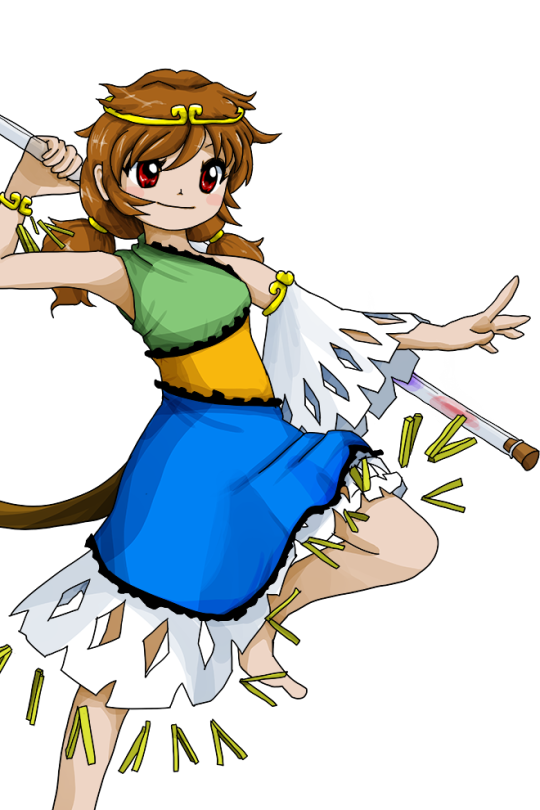
Sarugami means “monkey kami”, the monkey in mention being the Japanese macaque.To my best knowledge, the term is actually not used commonly in English - the results on jstor and De Gruyter are in the low single digits, Brill outright has nothing to offer. Translations are much more common.
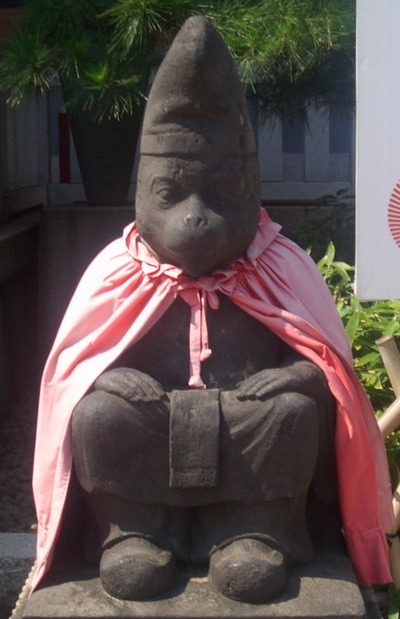
Sarugami are particularly strongly associated with Mount Hiei. You might have heard of it because of its association with Matarajin, though in this case he’s not exactly relevant. Instead, it is believed the monkeys act as messengers of Sanno (the “mountain king”), Sekizan Myojin and Juzenji. Sanno himself could take the form of a monkey according to medieval texts, while Juzenji can be accompanied by a deity depicted as a man with a monkey’s head, Daigyoji, known from the Hie mandala. Sarutahiko is also associated with monkeys based on the similarity between his name and the word saru. Bernard Faure notes that despite the clearly positive portrayal of monkeys as semi-divine beings in service of these deities, their perception in folklore and mythology can nonetheless be considered ambivalent, because they could be viewed as aggressive. There are even examples of sarugami being portrayed as monstrous antagonists to be defeated by a hero. The best known tale of this variety is known simply as Sarugami taiji. It is preserved in the Konjaku monogatari. Here the sarugami is a fearsome monster who terrorizes a village and demands the offering of one young woman each year.
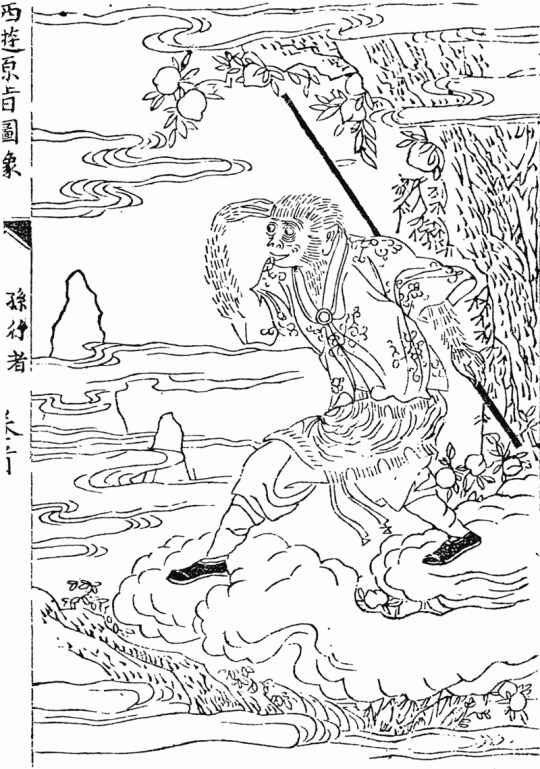
In contrast with the sarugami, I do not think Sun Wukong, one of the protagonists of the classic Chinese novel Journey to the West, needs much of an introduction. We reached the point where even in the west he is recognizable enough to warrant toys based on him (there’s a Lego Wukong on my desk right now). Biten's design has many callbacks to traditional portrayals of Wukong, including the staff (which in the novel is a pillar stolen from the undersea palace of a dragon emperor) and a very distinctive diadem (in the novel making it possible to pressure the unruly Wukong into obeying the monk he is meant to protect). As a curiosity it’s worth noting that “fake Wukong” is not a brand new idea - in the novel itself, one of the enemies of the heroes, Six-Eared Macaque, actually impersonates him for a time. Wukong is effectively himself a “divine monkey”, seeing as despite his origin as a literary character he actually came to be worshiped as a deity in mainland China, Taiwan and various areas with a large Chinese diaspora. The topic of Wukong worship itself came to be an inspiration for literature, starting with the excellent The Great Sage, Heaven’s Equal by Pu Songling, a writer active during the reign of the Qing dynasty, in the early eighteenth century.
2. Enoko Mitsugashira - “immortal yamainu” + Cerberus

Enoko gets the least coverage here, because there really isn’t much to say. Yamainu, “mountain dog”, isn’t really a supernatural creature, it’s an old term for either the extinct Japanese wolf, a type of feral dog, or a hybrid between these. It can also be used as a synonym of okuri-inu, a youkai wolf believed to accompany travelers at night.

There’s actually a distinctly Journey to the West-esque component to Enoko’s backstory, but I have no clue if this is intentional. In the aforementioned novel, many of the antagonists, who are generally demonic animals, are motivated by the desire to devour the flesh of the protagonist, the Buddhist monk Tang Sanzang, because it is said to grant immortality. Granted, given the obscurity of the figure Zanmu is based on - more on that later - perhaps this is an allusion to something else we have yet to uncover. Cerberus, being probably one of the most famous mythical monsters in the world, does not really need to be discussed here. The illustration is included mostly because I like Edmund Dulac and any opportunity is suitable for sharing his illustrations. I do not think it needs to be pointed out that Enoko's bear trap weapons are meant to evoke Cerberus' extra heads.
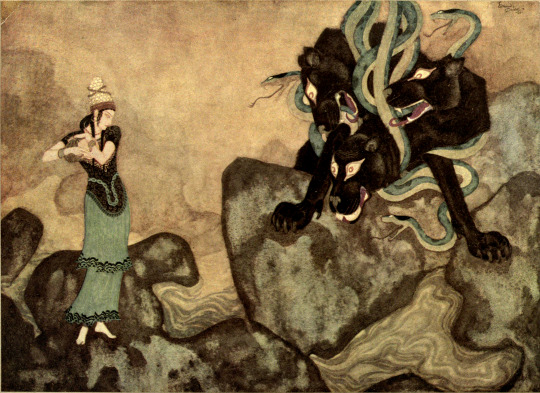
3. Chiyari Tenkajin - tenkaijin (+ mujina) + chupacabra
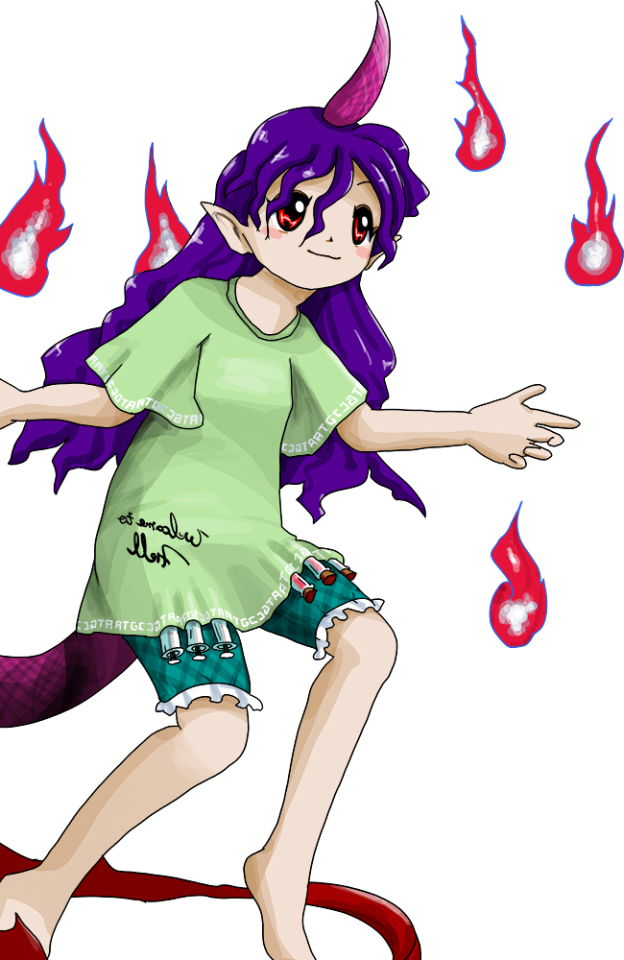
While my favorite animal youkai not yet featured in Touhou is easily the kawauso (otter), I was very pleased to learn we sort of got a mujina since I wanted to cover this topic since forever, but never got much of a chance. Technically Chiyari is actually meant to be a tenkaijin, which is not a mujina but a slightly different youkai (a will-o-wisp or St. Elmo’s fire-like creature, specifically) who in the single tale dealing with it takes the form of a mujina after dying, but as there is not much to say about it beyond that you will get a crash course in mujina folklore instead.

Today the word mujina is pretty firmly a synonym of anaguma - in other words, the Japanese badger. The animal does not substantially differ from other badgers, so I do not think much needs to be said about its ecology. However, historically the term could be used to refer to the tanuki regionally, or interchangeably to both animals, so in some cases if insufficient detail is provided it is hard to tell which one is meant. This ambiguity extends to the folklore surrounding them, and generally if you know what to expect from tanuki tales, which I’m sure most people reading this do, you will instantly recognize many of the plot elements typical for mujina ones. In other words, it is yet another yokai which typically takes the role of a shapeshifting trickster. Some supernatural phenomena could be basically interchangeably attributed to mujina, tanuki, kitsune or kawauso. Mujina are commonly described taking the form of Buddhist monks, which is one of the many similarities between them and tanuki.
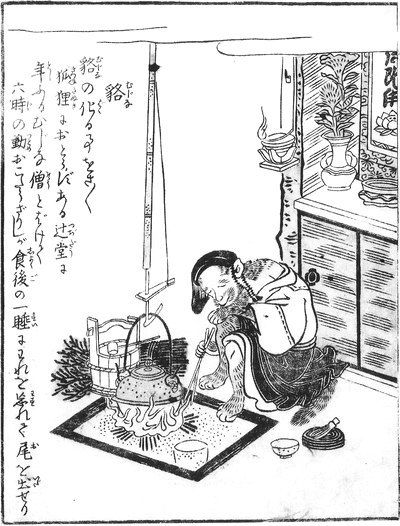
The most famous depiction of a shapeshifting mujina comes from Toriyama Sekien’s Konjaku Gazu Zoku Hyakki (The Illustrated One Hundred Demons from the Present and the Past). The accompanying text compares the creature to the supernatural versions of kitsune and tanuki, and states that the artist relied on a tale according to which a mujina was able to successfully impersonate a Buddhist monk until accidentally revealing its tail.
What makes the mujina special is that it is actually the oldest recorded example of a youkai of this sort. A mujina tale already appears in the early Japanese chronicle Nihon Shoki, dated to 627. It reports an incident of a mujina transforming into a human and singing somewhere in the Michinoku Province. I feel like this alone is a good example of why you should be wary of people who seek to present Nihon Shoki or Kojiki as historical truth. Western audiences as far as I know were first introduced to mujina by Lafcadio Hearn. To my best knowledge, the fabulous shapeshifting badgers however failed to gain the popcultural recognition enjoyed by tanuki and kitsune. They did appear in Shigeru Mizuki's stories every now and then, and I found a mascot character based on them, but overall there isn't all that much beyond that.

Naturally, there isn't much mujina in Chiyari's design, and she instead most likely owes her distinctly spiky appearance to the other inspiration behind her character, the chupacabra. Mujina are not really portrayed as bloodthirsty, but the poorly documented tenkajin apparently is, which is presumably why ZUN decided to connect Chiyari with the chupacabra, the best known modern blood-drinking creature, who first appeared in tall tales from 1995 and subsequently took popculture by storm after spreading from Puerto Rico to mainland USA and Mexico. I am not a chupacabra aficionado so I have little to offer here, sadly.
4. Hisami Yomotsu - yomotsu-shikome
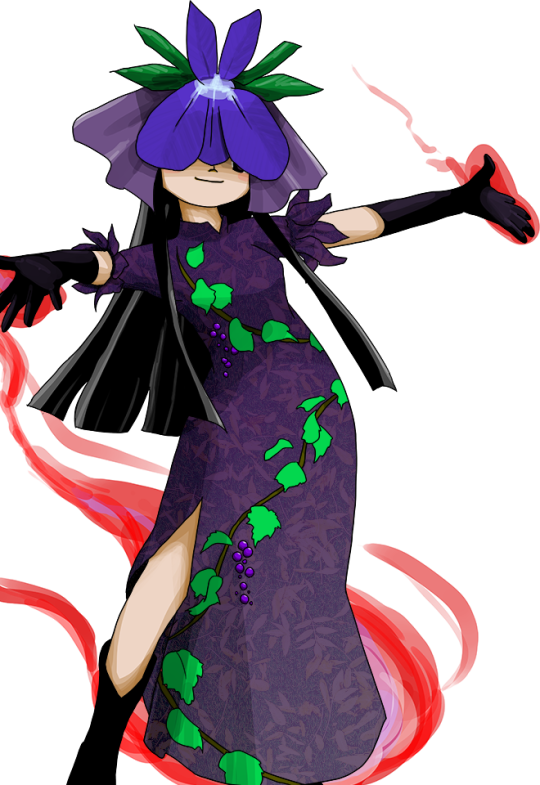
Judging from what I’ve seen on social media and on pixiv, Hisami is shaping up to be one of the most popular new characters (she’s my fave too). In sharp contrast with that, her basis is pretty obscure. So obscure that there isn’t even any historical art to showcase, as far as I can tell (note that this blog claims night parade scrolls might have something to offer, though - I was unable to verify this claim for now, sadly). As we learn from her bio, she is supposed to be a yomotsu-shikome. They’re called the “hags of Yomi” of Yomi in Donald L. Philippi’s Kojiki translation. The term shikome can be literally translated as “ugly woman”. Nothing about them really implies femme fatale leanings we are evidently seeing in Touhou but I’m not going to complain about that. Yomotsu-shikome appear only in the Kojiki and the Nihon Shoki, and in both of these early chronicles they are portrayed as servants of Izanami after she died and came to reside in Yomi, the land of the dead. Nihon Shoki states there are only eight of them. The distinct grape vine motif present on Hisami’s clothes seems like an obvious reference to Izanagi’s escape from Yomi following his meeting with Izanami, portrayed in the myth recorded in both of these sources. When the yomotsu-shikome started to pursue him, he threw a vine he used to hold his hair at them. The plant instantly bore fruit, which the entities started to eat. They later resumed the chase, but were once again held back, this time by a bamboo shot. According to the Nihon Shoki, they eventually give up after he creates a river from his piss (sic) to keep them away.
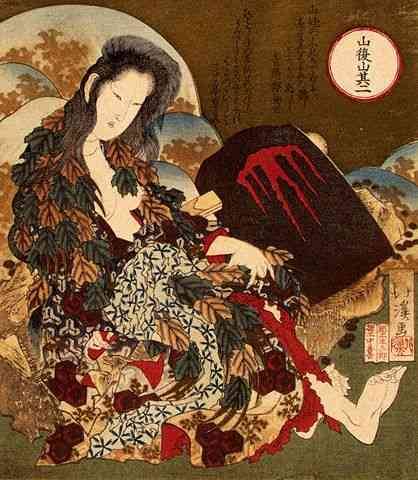
Yomotsu-shikome are sometimes compared to oni by modern researchers. Noriko T. Reider in her monograph about oni argues that alongside hashihime and yamanba (pictured above) they can be effectively grouped with them. Another researcher, Michael D. Foster, is more cautious, and states that despite clear similarities it’s best to avoid conflating oni-like female demons with female oni proper, especially since the latter have a distinct iconography and a distinct set of traits. Norinaga Motoori, the founder of kokugaku or “national learning”, a nationalist intellectual movement in Edo and Meiji period Japan, claimed that oni were based on yomotsu-shikome, which is a pretty dubious claim. It is ultimately not certain when the term oni started to be used, but it is safe to say it has continental origin. And, of course, oni permeate Japanese culture in a way yomotsu-shikome do not.
5. Zanmu Nippaku - Zanmu
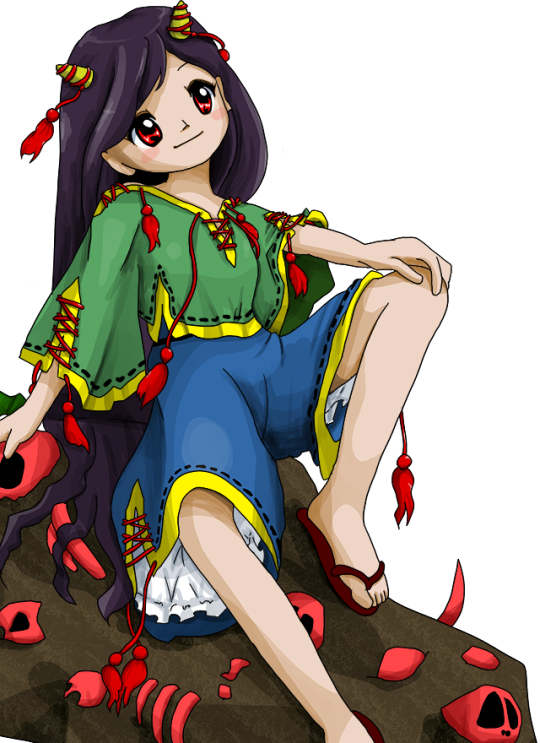
This was the toughest mystery to solve, and I am fully indebted to 9 here, since they figured it out, I am merely depending on what they directed me to. Research is still ongoing, and it feels like we just started to untangle this mystery, so you can safely expect further updates. Zanmu appears to be based on the Buddhist monk… well, Zanmu. You can learn a bit about him here or on Japanese wikipedia; it seems there are quite literally 0 sources pertaining to him in English, and even in Japanese there is actually very little. Their names are not written the same, ZUN swapped the sign for “dream” from the original name for one which can be read as “nothingness”. If the unsourced quote on wikipedia is genuine, the reason might be tied to the personal views of the irl Zanmu. What little we’ve been able to gather about him is that he was active in the Sengoku period, and apparently was regarded as unorthodox and eccentric. This lines up with Zanmu’s omake bio pretty well. Seems the real Zanmu was also unusually long lived, and was able to recall events from distant past in great detail, though obviously the figure of 139 years attributed to him in a few places online has to be an exaggeration.
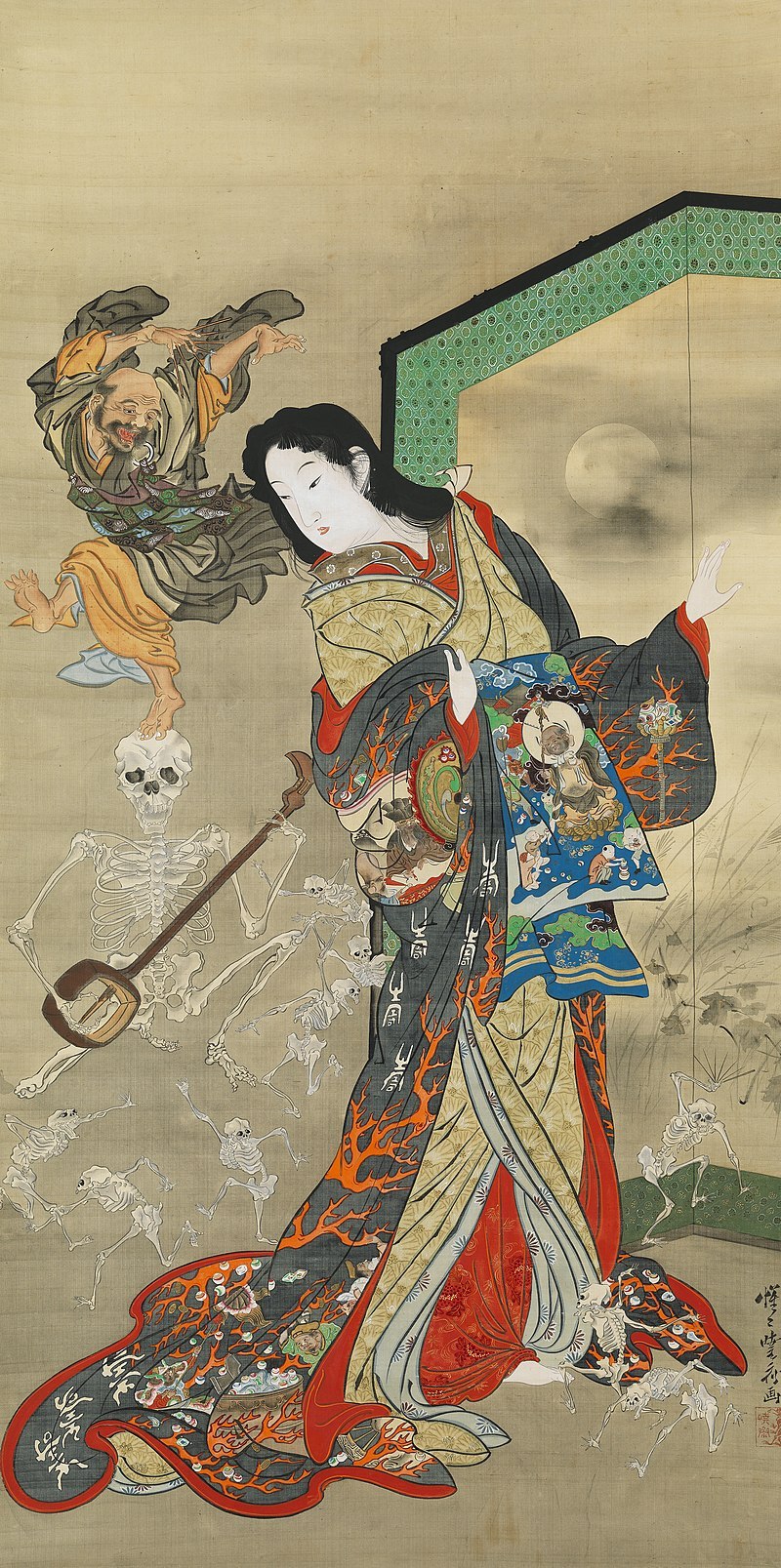
Yet more puzzling is the reference to Zanmu’s familiarity with Ikkyo you might spot in the linked article. Whether the famous Ikkyo who you may know from the tale of Jigoku Dayu is meant is difficult to determine. The chronology does not really add up; on the other hand the logic behind associating one eccentric semi-legendary monk with another in later legends isn’t particularly convoluted. As 9 pointed out to me, if ZUN was aware of this link, and the same Ikkyo really was meant, it is not impossible the connection between Zanmu and Hisami is meant to in some way mirror that between Ikkyo and Jigoku Dayu. As you can easily notice, it’s pretty clear the historical Zanmu was male. It does not seem his Touhou counterpart is, obviously. I would say we should wait for more info until declaring that we have a second Miko situation on our hands, with a male historical figure directly reimagined as a female character without any indication we are dealing with a relative rather than the real deal. There’s still relatively little info to go by so I would remain cautious (though naturally this is not meant to discourage you from having headcanons).
Neither me nor 9 were able to find any connection between the historical Zanmu and oni… so far, at least. Therefore, what motivated ZUN to make Zanmu an oni remains to be discovered. As a final curiosity, on a semi-related note it might be worth pointing out that while not as common as their male peers, female oni are not a modern invention, and already appear in setsuwa from the 13th century. A particularly common motif are tales describing a woman turning into oni due to jealousy or anger. Further reading:
Jason Colavito, The Secret Prehistory of El Chupacabra (2011)
Bernard Faure, Gods of Medieval Japan vol. 1-3 (2015-2022)
Michael Daniel Foster, The Book of Yokai. Mysterious Creatures of Japanese Folklore (2015)
John Knight, Waiting for Wolves in Japan. An Anthropological Study of People-wildlife Relations (2003)
Noriko T. Reider, Japanese Demon Lore (2010)
279 notes
·
View notes
Text
Omnia Vinces | 所向披靡
“You will conquer all”
A gift fic for a talented writer/artist from the Chinese-speaking LU community!
Synopsis: Summoning his last reserves, Ravio bestows a powerful gift upon Legend, urging him to complete the mission before darkness consumes them all.
🗺️ The first chapter is my writing in Chinese, and the second will be my own English translation.

#linked universe#lu ravio#lu legend#lu fanfiction#gift fic#lu whumptober#whumptober 2024#omnia vinces
38 notes
·
View notes
Text
Info for writer in Thai series fandom: Pronouns and prefixes
Phi, Nong, Hia, Jèe, Tee, Muay, Khun, Phom, Nai, Tur, Nhu, Taan, Chan,Rao, Gae, Mung, Gu, Man
Gender-neutral
The pronouns or prefixes chosen for themselves and others will depend on a lot of factors such as age, preexisting relationship, mood, place, and occasion. And it has no rigid rule one can refer to. Sometimes it will change rapidly. Sometimes it will stay the same.
In one conversation, one can use more than one set with the same person.
Sometimes it might be chosen after a thought process and careful consideration, but most of the time it's likely just habit or instinct.
พี่ Phi
Can be used with or without a name.
Polite but not particularly formal
Can be used to refer to the first, second, or third person.
The literal meaning is "elder sibling," but it can be used to call anyone older. And since it's polite but not too formal, it gets used all the time. The chance that someone will get offended by being called Phi is really low. It can also refer to a lover, despite being a family term. I understand that it might look a bit weird when someone tries to translate it to English and decides to use bro or something along that line, but it's normal here.
Sometimes older relatives will call a child in their family that has a younger sibling Phi, and in that case, the child might call themselves Phi when speaking to them too. But that is the only situation I know of where the one Phi refers to, in a non-teasing way, is younger. (Not counting times where both parties didn't know each other's age and so they both insisted on calling the other Phi to be polite.)
When someone calls themselves Phi, they might refer to the other party as nong, khun, nai, tur, nhu, name, or pet name.
น้อง Nong
Gender-neutral
Can be used with or without a name.
Polite but since Thai culture focuses on respecting the elderly a lot, terms that are used to address someone younger can sometimes be seen as disrespectful.
Can be used to refer to the first, second, or third person.
Nong is Phi's counterpart. Its literal meaning is "younger sibling." It is mostly used in the same way as Phi, but for younger people. And, unless they are related, when someone calls themselves Nong, they will likely only refer to the other party as phi (with or without a name). As for when they are related, like, when they talk to their grandma, and they refer to themselves as nong+name they, for obvious reasons, will refer to Grandma as Grandma rather than Phi.
เฮีย Hia
Masculine
Can be used with or without name.
Casual
Can be used to refer to the first, second, or third person.
The literal meaning is "elder brother" but get use for older man in general too. The word has Chinese roots (Teochew dialect), so if someone is referred to as "hia", it's safe to assume he has a Chinese ancestor, but not all people who have a Chinese ancestor will be referred to by the word that has Chinese roots. It's up to their personal preference. The same is true for jèe, tee, and muay.
เจ๊ Jèe or Che or Jay (I'm not sure how to write this in english)
Feminine
Can be used with or without name.
Casual
Can be used to refer to the first, second, or third person.
The literal meaning is "elder sister." For some reason, people use it to call women who are in charge of small businesses a lot, especially in the restaurant and construction industries. While it's not exactly rude, many people don't like it.
ตี๋ Tee
Masculine
Use without a name.
Casual
Can be used to refer to the first, second, or third person.
The literal meaning is "younger brother." Sometimes it gets used as a nickname or to describe people who have light skin and single eyelids. Most don't see it as a negative thing. People won't use it to refer to other people's younger brothers in the same way that you use the word "younger brother." For example, they won't say "how your tee is doing" but they might say "how tee is doing."
หมวย Muay
Feminine
Used without a name.
Casual
Can be used to refer to the first, second, or third person.
The literal meaning is "younger sister". Used just like tee.
All four hia, jèe, tee, and muay may say with ah in the front. like ah-muay, ah-hia It didn't add or change any meaning of the word. It's just a sound.
คุณ Khun
Gender-neutral
can be used with or without a name.(I kind of feel like Khun with the name can be a bit more respectful and Khun without a name can be a bit more casual)
Formal
can be used to refer to a second or third person.
It can be translated to you, miss, mister, sir, etc. It can also be translated to virtue, benefit, and the like in other contexts, but we won't talk about that.
Most formal settings will use khun, with the exception of those who have a rank or special prefix like doctor or soldier. In the workplace, co-workers will use khun to call each other if they are not yet close. In a hospital, the doctor and nurse will use khun to call the patient, and the patient will add khun to the word that means doctor and nurse when calling them. In universities, many professors use khun when they talk to students. Even in school, specifically in my class, we used to call each other Khun(without names) before we grew up and gradually became more familiar with bad words like Gu(กู) and Mung(มึง).
**If we already call someone using "Khun + name" as a second person, then it is likely to be used as a third person too.
But just because it's not quite casual doesn't mean it can't be intimate. Many lovers will call each other khun. In some pairs they will both use it. In some pairs only one of them will use it and the other may use their lover's name or pet name. Like my grandparents, my grandma called my grandpa khun+name and he called her by her name.
If only one of them used khun to address the other, the chance is they are the younger of the pair.
The pairs that used khun were usually people who had used it since the beginning before they got together. But they might just try many ways to call each other and then decide that they like it best.
ผม Phom
Masculine
used without a name.
Quite formal and polite.
used to refer to the first person only.
translated to "I". It is a common way to call themselves as it is appropriate for all ages and all occasions. Children call themselves that when they talk to their mom and all the other adults in their life. A grown man called himself that when he talked to his subordinate and supervisor alike. It may be paired with khun, tur, tan, nai, phi, hia, jèe, or other party names.
นาย Nai
Masculine
used without a name.(when used as a pronoun)
casual pronoun that is quite polite, an official title for every man aged more than 15 years old, and can also be translated to boss, owner, employer, etc. But in this chapter we are going to talk about it as a pronoun only.
It can be used to refer to a second or third person. But for the third person, it will be in a very specific form. It will be along the lines of "that person/that one (นายคนนั้น-nai-kon-nan), you remember right?" And nothing else. At least there is nothing else I can think of.
It translates to "you". It's not the most popular nowadays, but it's not very rare either. It is mostly used among friends and people around the same age.
เธอ Tur
Gender-neutral but can be considered a little more feminine than masculine in the present time.
used without a name.
It is polite but only used to address someone who is at the same or lower level, never higher when it usu as you.
Technically, it can refer to both the second and third person. However, it is mostly used in the second person these days. It can be seen as a quite sweet way to call others. Many couples used it.
หนู Nhu
Gender-neutral but considered more feminine than masculine.
It can be used with or without a name.
can be used to refer to the first, second, or third person.
It is used by young boys and girls to call themselves when talking to older people, but when most of the boys grow up a little, they will likely stop using it. In their teen years, it's quite rare to see them call themselves that, except when they talk to their mom or people they used to use it with when growing up. Most of the girls will stop too, but a lot slower. Some (not the majority in my opinion, but I also wouldn't say it's that small of a percentage) might use it well into adulthood, like until most people around them are not that older than them anymore, and some, typically those who view their position as low in social standing, will use it even with people younger than them (but in a higher position in their opinion). When it's used by older people to call younger people, it's usually to girls more than boys and quite a young person more than an adult. It is possible to offend the receiver by calling them nhu since it can be seen as not taking them seriously, belittle them, or treat them like a child. It's polite to call yourself nhu, but by doing that, you risk presenting yourself as in a lower position than who you speak with, young, and not in a position of power.
ท่าน taan
Gender-neutral
It can be used with or without a name.
polite and formal.
can be used to refer to both second and third persons.
can be translated to you, he or she. It's used when we call someone with a lot of respect. For example, royalty, monk, CEO, your cat whom you will serve and die for, president.
ฉัน chan
Gender-neutral
used without a name.
Polite
used to refer to the first person only.
translated to "I". Used when talking to someone the same age or younger a lot more than when talking to someone older. Get paired with khun, tur, gae, and taan.
เรา Rao
Gender-neutral
used without a name.
Polite
Can be used to refer to the first, or second person.
Translate to I, we, or once in a while, you. Polite way to say "I", and a normal and not more polite than usual way to say "we". It's usually used only with people in the same age group. It was used as "I" by Ae from love by chance.
แก gae
Gender-neutral
used without a name.
A little rude, but less rude than Mung.
It can be used to refer to both second and third persons. But the second person is more common than the third person.
translated to "you." Many girls in BL used it. It can be used by anyone at any age to call anyone the speaker is close to or isn't afraid to be rude to.
มึง Mung
Gender-neutral
used without a name.
Rude
used to refer to the second person only.
The meaning is "you."
กู Gu
Gender-neutral
used without a name.
Rude
used to refer to the first person only.
The meaning is "I."
Both Mung and Gu get used in the series all the time, so I don't know what to add, but it feels weird if I don't include it.
มัน Man
Gender-neutral
used without a name.
Rude
used to refer to the third person only.(if used as pronoun)
Translate to it(normal) or he/she(rude).
+Bonus
"You" and "I" in English as a pronoun when speak Thai.
It's not that common, but it's also not that weird. People who do that are those who typically also use many other English words. As for the situation, it should be in a casual setting with people who are on the same level or lower in social status, i.e., not an elder, teacher, boss, ect. And like in English, you and I are gender neutral.
Used only the name all the way, no other pronouse.
as a first person
It's more feminine than masculine, since it's seen as an attempt to be cute. I did use it with my family growing up, so it was natural for me to always use it with them, but when I used it with my friends, I did it with the intention of irritating them by acting overly cute.
as a second person
It's also more feminine(?), but for the speaker, not the name's owner. I'm not so sure about why. I just don't see men do it(except with kids). You should be at some level of closeness before you do it. I usually use it with my classmate, who I am not super close with but not, not close either. I guess it's just my default when I don't want to be rude bu also afraid to be overly polite and weird them out.
Used name to refer to a third person is just a normal way of speaking.
Some titles used in Khun Chai's explanation
Here
Other things
There are no words for your, his, and her in Thai, so if it can be translated to you, it can also be your and so on.
Calling someone noticeably older only by their name is not a common practice and can easily be seen as rude. There is always a prefix one can and should add when addressing someone older.
People who met in a casual setting, have some level of closeness, attempt to be close, or are just easygoing usually use the same word set for family to call each other. You can see some in Chapter 14 if you want to. It's kind of the default choice, actually.
Index
224 notes
·
View notes
Text
Welcome to my Studyblr! ✨
I've been here since 2014 but well, I never got around to actually introducing myself, I guess? Here I go.
My name is Helen (they/he).
25 year old Queer Capricorn in Myanmar.
What am I learning? Well, a lot of things but mostly languages, literature, and psychology.
I am a native Burmese speaker but I also speak other languages! English (C2), Korean (TOPIK 6) Mandarin Chinese (HSK5) and Japanese (JLPT N3) respectively. I try to keep my certifications up to date but covid made it really difficult.
I'm working towards a Diploma in Pali.
I am also learning Spanish, Russian, Latin, ASL etc and absolutely getting my ass kicked by them.
I'm a freelance translator, writer, tarot reader, astrologist, language study guide, language instructor and a bookseller by trade!
I don't do all of those at once. I just sort of... rotate them if that makes sense. 2 at a time, 3 at a time etc.
I am very hardworking but I also have neck arthritis (Cervical Spondylosis), ADHD, Social Anxiety and Depression so it's a struggle.
I also have tons of hobbies. I like reading books, writing reviews, journaling and writing fan fictions etc so I'm all over the place.
I have a lot of stray cats that I've adopted so you'll get to see them obstructing my studies as well!
My life's not very glamorous. I'm in Myanmar. But I'm trying my best to hang on and also help others hang on. So you'll see me talking about free consultations and free lectures and humanitarian aid stuff etc.
I also run a paid telegram channel for tarot/oracle readings with my friends to fundraise for people in Myanmar.
I'm taking it one day at a time.
That's pretty much all of it! I hope y'all have a fun time looking at my posts.

#studyblr#langblr#chinese language#korean language#korean studyblr#bookblr#chinese studyblr#chinese langblr#japanese language#japanese studyblr#tarot#oracle#divination#astrology#freelancer#translator#burmese#myanmar#multiracial#nonbinary#queer#adhd#arthritis#neck arthritis#cervical spondylosis#chronic pain#social anxiety#capricorn#literature#100 days of productivity
148 notes
·
View notes
Note
I believe Cheating Men must die is a great story
It adds wonderful twists in existing tropes and genres. The protag isn't perfect but she's great, she likes eliminating assholes, which is valid
It's also interesting how Su Luxia doesn't have an identity issue since she lives under so many identities but I guess she's hardened for the job
For everyone who hasn't read Cheating Men Must Die (comic "Wan Zha Chao Huang" (万渣朝凰) by Shi Dai Man Wang (时代漫王)), this is an open invitation for y'all to read it. Genre: quick transmigration, revenge story. Basically your ex-cannon fodder MC, Su Luxia, is a System agent who transmigrates (isekais/ world hops) into the bodies of women of each world who are wronged by the Male Lead, Female Lead, another canon fodder, author, etc and changes their fate. I forgot how many chapters of the manhua there are presently fan-translated but I believe the current season finale in Mandarin Chinese ends at over 800+ chapters of art. (The link has the MTL English translation, but if you don’t like MTL y'all can also peep at other sites for ENG fan-translations.)
There are a couple of different summaries but I love this summary the best:
Don't you think that all cheating sc*m need to die? Su Luxia, an intern pro working in a transmigration agency, doesn't believe in that. For her, all cheating bastards need to rot in hell before they die. Or else they won't suffer the taste of their own medicine! Using elaborate means, she beats up countless cheating bastards and b*tches. Su Luxia sneers... "People take everything they get for granted. The more they get, the more they don't strive for it. An unrequited love is an example. There is always a sc*m who takes advantage. Since they brought this upon themselves..." She studies her face in the mirror and smirks, "... let them have a taste of their own medicine." System: "You're making that scary face again!" Follow our female main lead, Su Lüxia, who is bound to the Female Lead Counterattack System and transmigrates to several small worlds beating up countless sc*m.
Art bait for y'all who are still hesitating (and some of my favorite arcs, and those that'd surprised me like the arc where she transmigrated into the Second Male Lead):
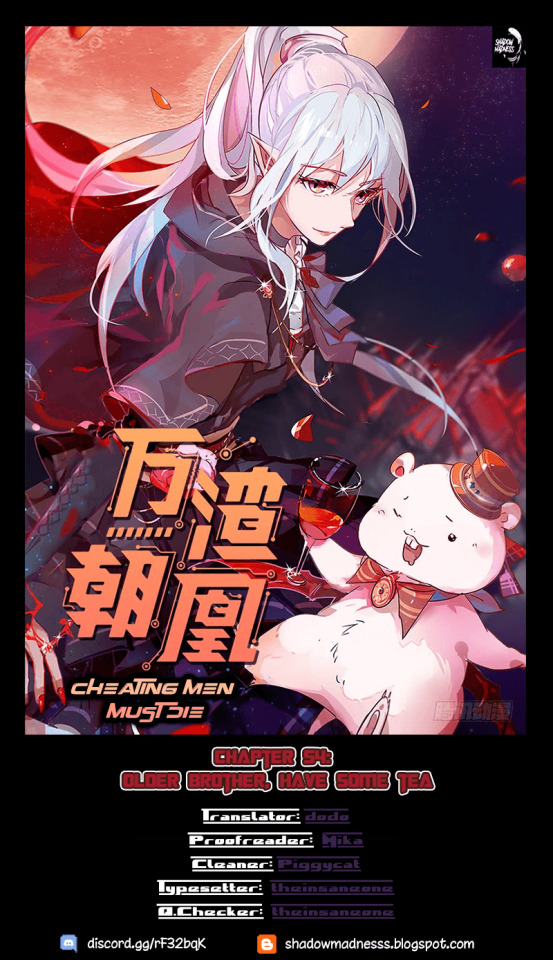
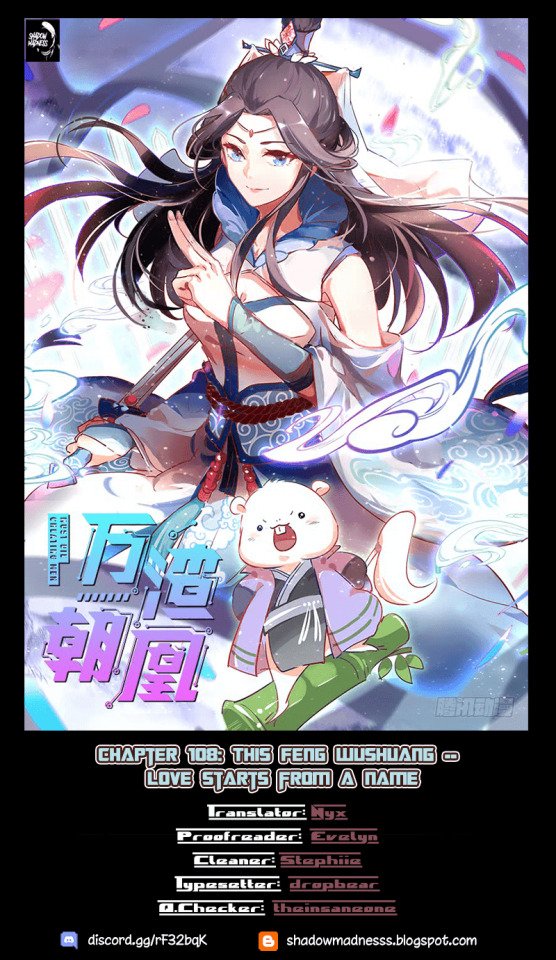
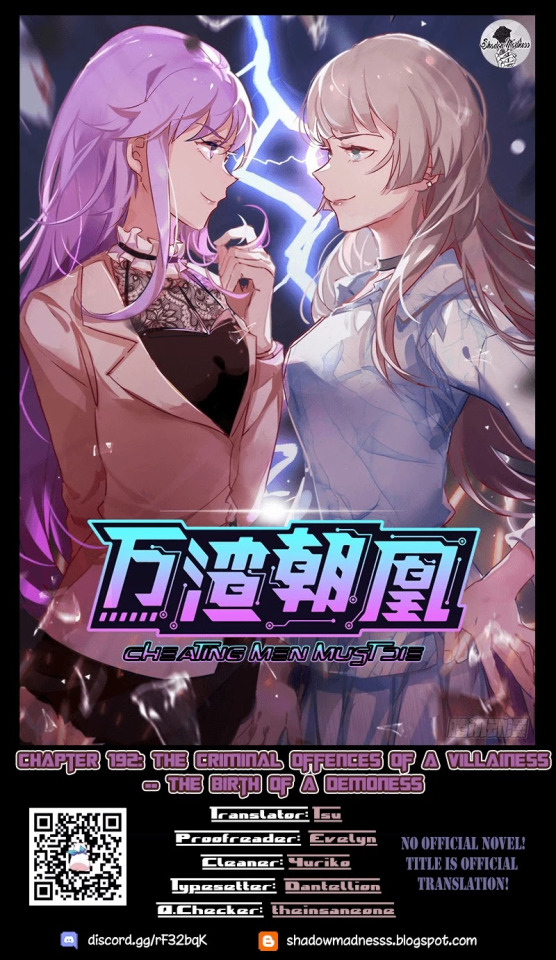
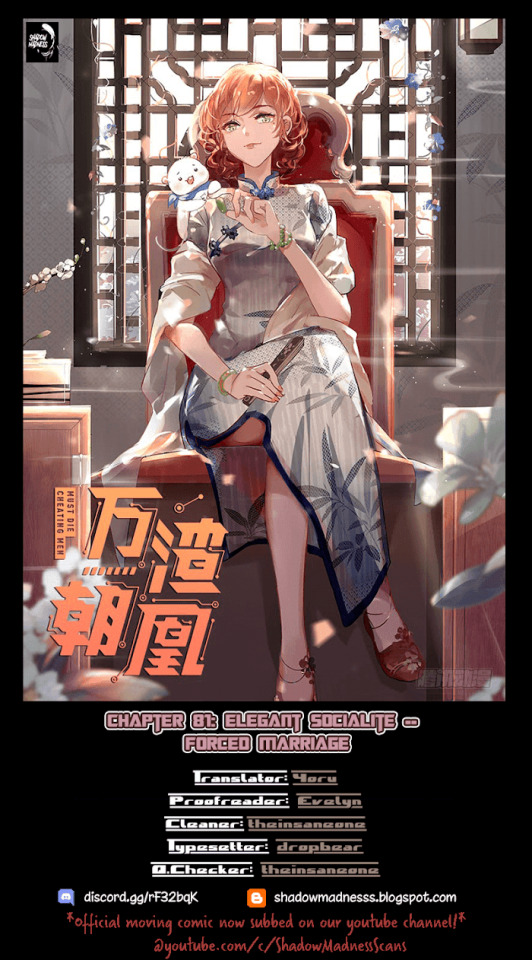
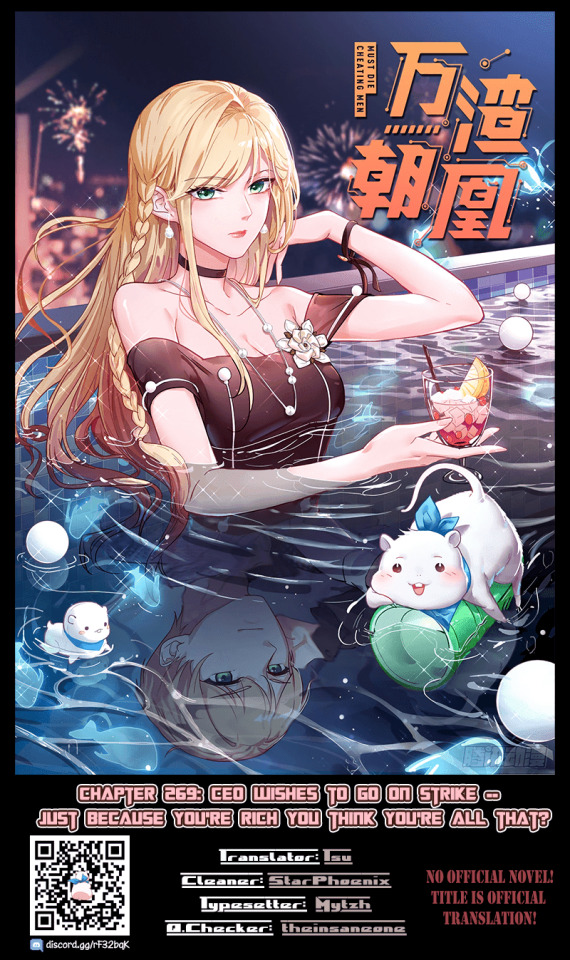
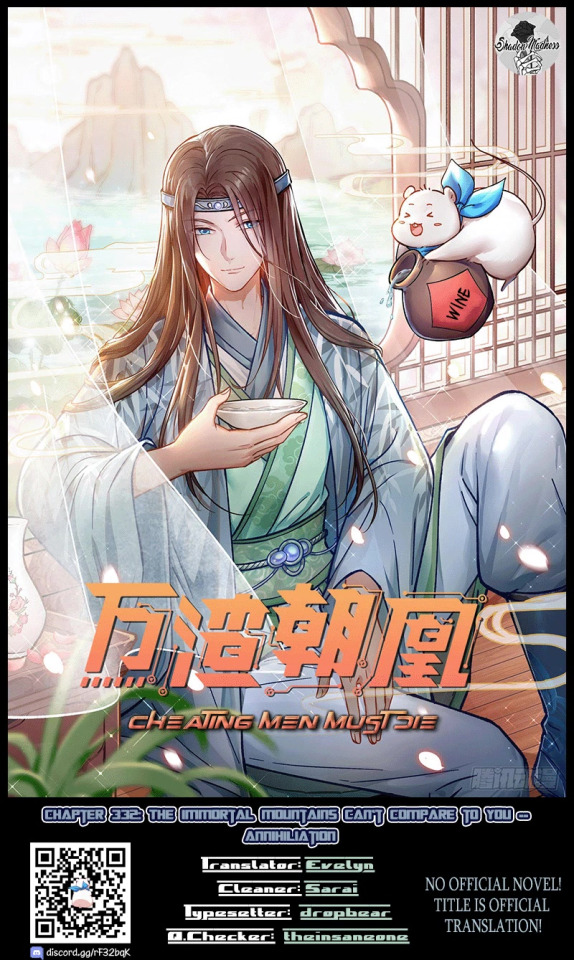
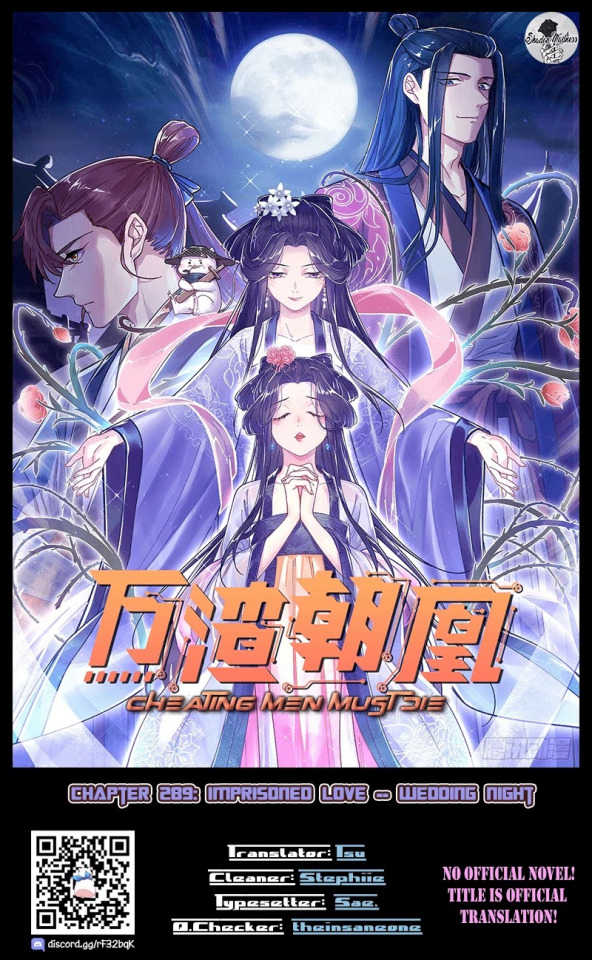
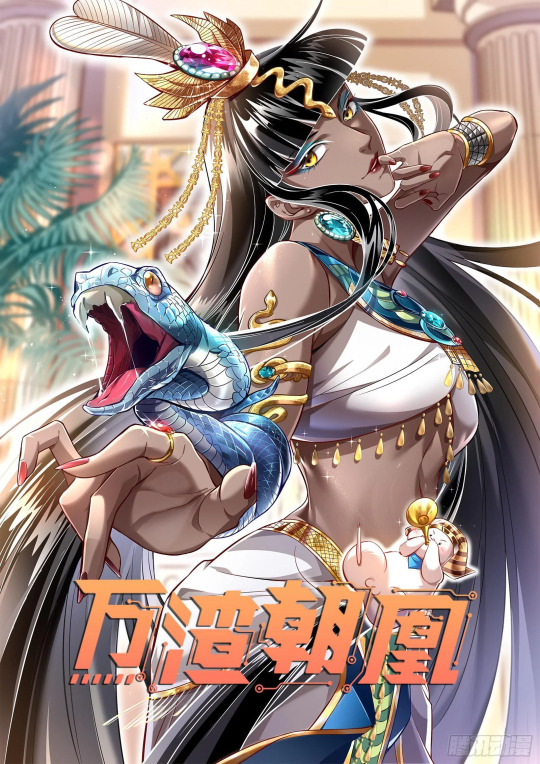
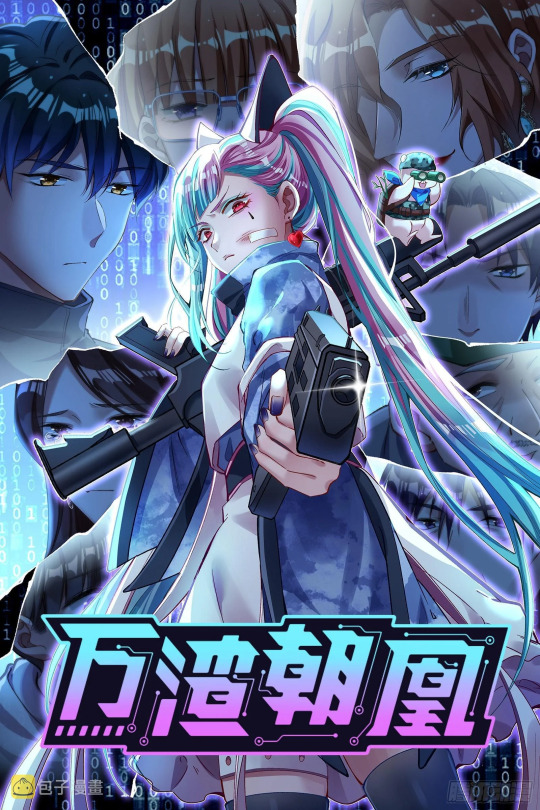
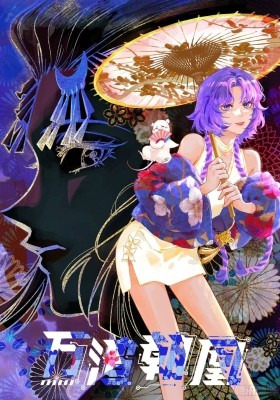
RE: I have to agree! Ty for the Ask, @bernkastel11! I had a response ready for ya the day I saw this in my inbox and literally typed a long essay with links, but lo and behold tumblr ate it. 😭 But finally I have the motivation for a take 2. Honestly the manhua is a guilty pleasure of mine. The art's great (we definitely see the artist improve over time with each arc...even with the obviously borrowed assets and sometimes janky perspective, hahaha) and I love how Su Luxia is a badass femme fatale (white lotus & green tea b*tch), as well as her friendship with her cute talking hamster System. I also love how the artist is giving variety; it's not all just kicking butt, chewing bubble gum, finding romance. She's become an empress, made a friendship with the exorcist Female Lead, become a mother, led revolutions, survived a death game, became a guy, made a Male Lead yandere and obsess over her to the point of trying to hunt her down in whichever world it is, has some...questionable sapphic overtones, transmigrated into a BL novel, revisited some worlds with reoccurring characters, etc. They satirize a lot of preexisting tropes, and I love it when artists and writers have fun with the meta. I also like how they're slowly expanding on the lore of her interest with previous System agent Zero (the whole reason why Su Luxia became a System agent).
"It's also interesting how Su Luxia doesn't have an identity issue since she lives under so many identities but I guess she's hardened for the job"
The thing about QTs in general is the artist or author usually don't put much emphasis on the consequences of transmigrating so many times into other people's bodies. It's just a staple of the genre (because they're usually portrayed as badass, cunning, and OP, what have you with a strong willpower to assume all these identities, overcome challenges, and not experience dysphoria). So far I think the only writer I can think of off the top of my head that addresses it is: The Exhausting Reality of Novel Transmigration (novel / manhwa). I highly rec it. So far it is one of the few works where they explore that concept of how mentally exhausting it is adopting another person's identity as well as the consequences of "the characters" finding out (it's not your usual "oh, you hopped into my dead daughter's body and assumed her identity? Well la de dah, guess you're my daughter now." No, we're talking about the mother suspecting, finding out, being horrified, and having a mental breakdown trying to exorcise "the evil spirit" who's taken possession of her daughter's body). It also touches on the danger of an ordinary woman transmigrating into the body of a Female Lead in an R18+ novel where the Male Lead is a yandere.
Since you'd mentioned CMMD, I can give you several other links:
Cheating Men Must Die animated audio version of the first few arcs (King of the Phoenix), comes with ENG subs
Mission in Parallel 2022 Chinese short drama (it's the late 1910s socialite arc where she transmigrates as the overweight nightclub owner & wife of the abusive husband who gets seduced by a singer who's also a transmigrator), comes with ENG subs
Cheating Men Must Die (2022)(it's the arc where she transmigrates into the world where she's the villainess and the CEO Male Lead is self-aware, and the author has signed with the evil System trying to kill off Su Luxia so that she herself can transmigrate into the body of her own FL), comes with ENG subs
#cheating men must die#manga rec#The Exhausting Reality of Novel Transmigration#reading recommendations#ask#ty for the ask <3#bernkastel1#it's so nice to find another CMMD enthusiast; usually I'm the one reccing CMMD to everyone else hahahaha#phoenix talks
43 notes
·
View notes